Industrial Hoses
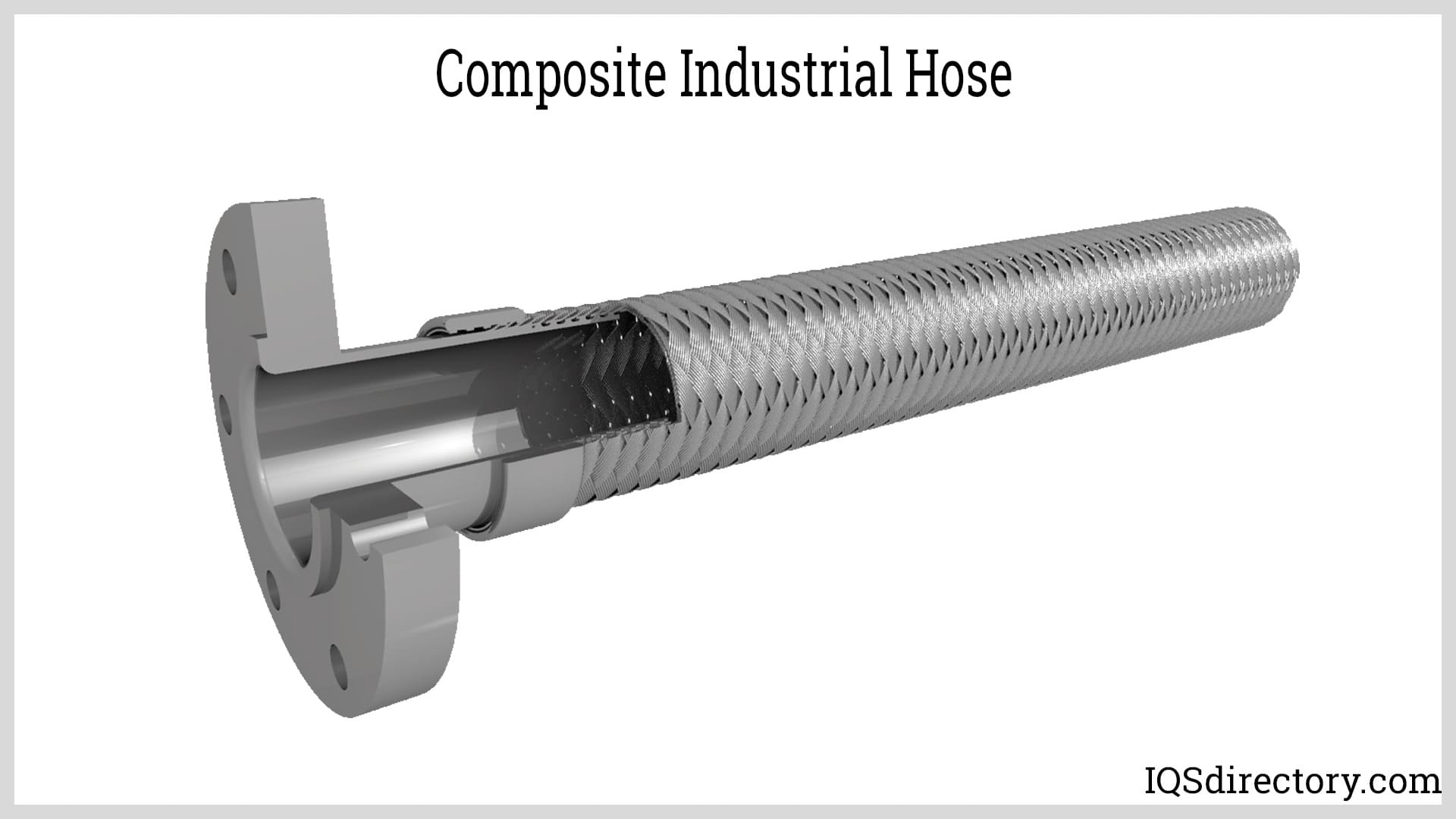
An industrial hose is a durable and precision constructed hose used to transfer and transport liquids, gases, and other materials for industrial applications. They are made of materials that...
Please fill out the following form to submit a Request for Quote to any of the following companies listed on
This article will take an in-depth look at Polyvinyl Chloride (PVC)
The article will take a look at topics such as:
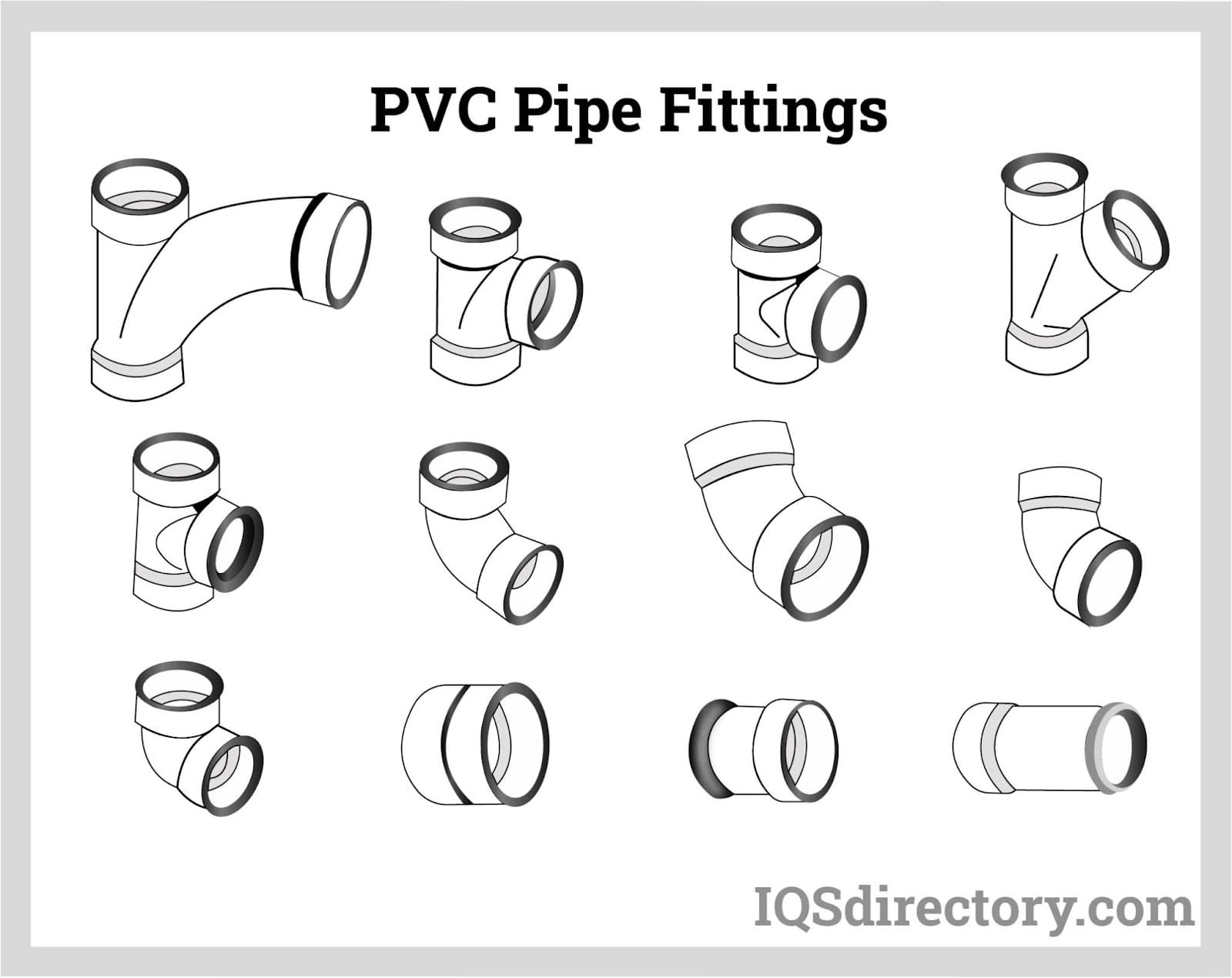
This part dives into Polyvinyl Chloride (PVC), elucidating the procedure used in its manufacturing.
Polyvinyl Chloride, abbreviated as PVC, is a robust, white, brittle thermoplastic known for being lightweight yet resilient. Economically feasible and easy to process, PVC was originally synthesized by German chemist Eugen Baumann in 1872. He discovered it by exposing a tube filled with vinyl chloride gas to sunlight, resulting in the formation of a white solid, which we call PVC today. Widespread use only began in 1913, primarily as a corrosion-resistant piping material.
PVC is available in several variants, such as flexible, unplasticized, perchlorovinyl, molecularly oriented, and modified forms. Its hallmark properties include dielectric strength, durability, flame retardancy, low cost, and resistance to abrasion and chemicals.
Given that PVC resin generated by polymerization displays low thermal stability and high melt viscosity, its attributes are often modified using various additives in production. Additives like heat stabilizers, UV protectants, plasticizers, impact modifiers, fillers, flame retardants, and pigments enhance PVC's stability.
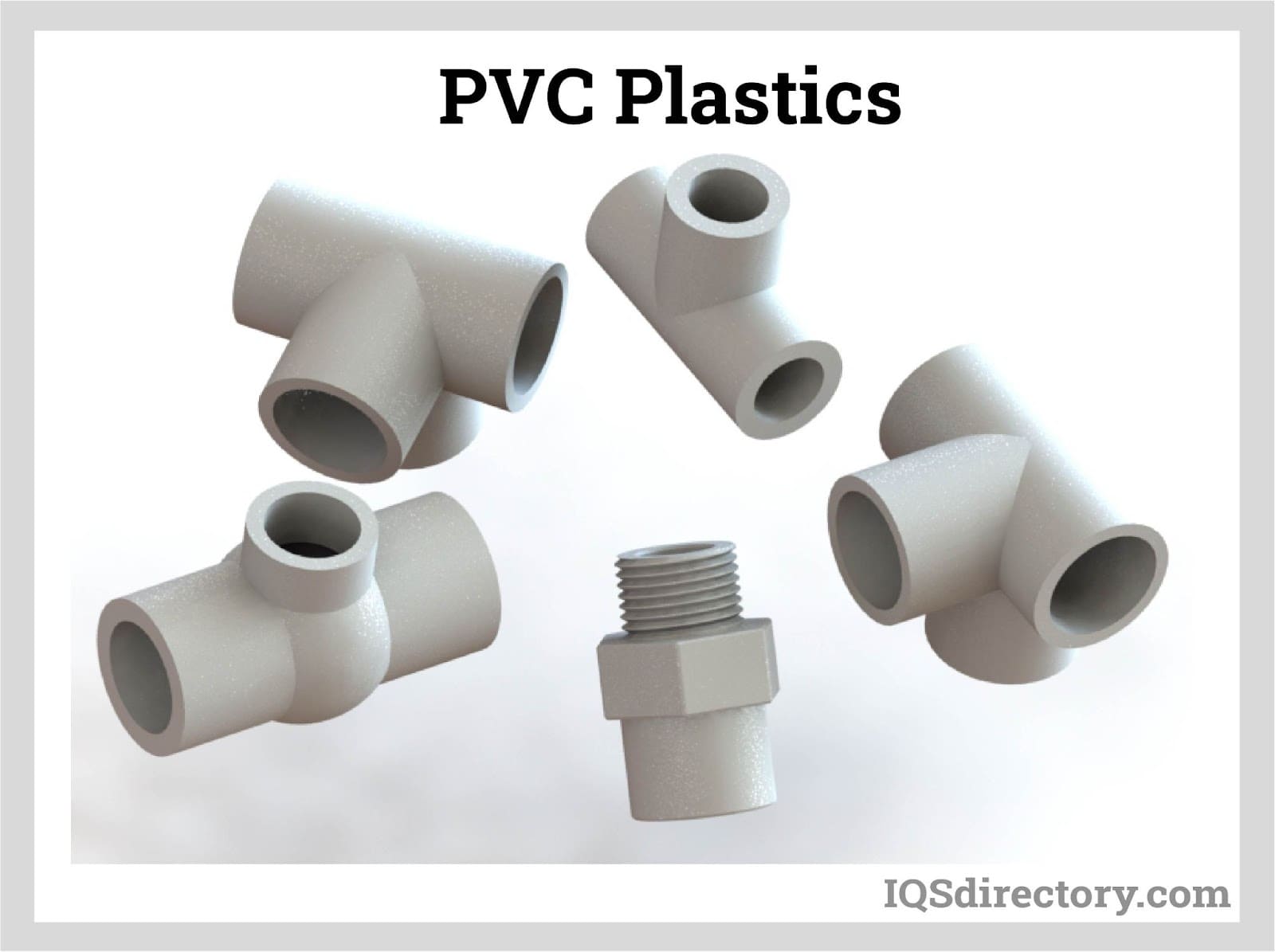
PVC is created by polymerizing vinyl chloride, with its features changing based on the plasticizer applied. Plasticizers are low molecular weight substances added to increase PVC's flexibility and plasticity. They primarily adjust the polymer's attributes to fit specific applications. For optimal performance, plasticizers should have chemical compatibility with the PVC polymer.
This section delves into how Polyvinyl Chloride is manufactured.
Unlike other thermoplastics fully reliant on petroleum, PVC is made from two key raw materials, reducing dependence on non-renewable fossil fuels during production. Specifically, 57% of PVC comes from common salt, while the remaining 43% derives from hydrocarbon feedstocks.
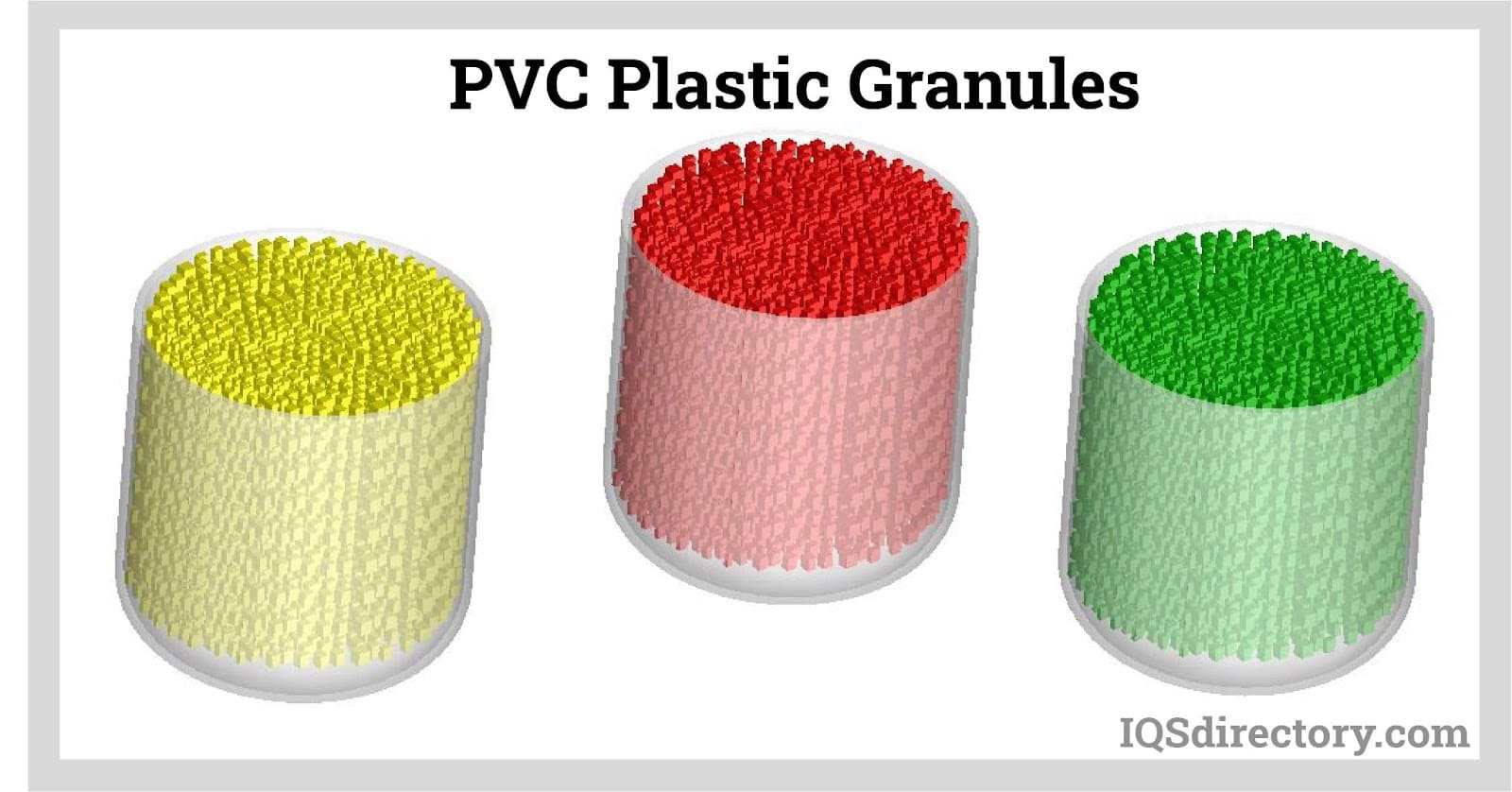
Recently, ethylene from sugar crops has been increasingly used as an alternative to natural gas or oil-derived ethylene for PVC production. Though PVC is commonly made from oil and salt, in certain regions it is produced without any oil feedstock, substituting oil-derived hydrocarbons with bio-sourced ones, making it less dependent on oil compared to other thermoplastics.
Known for exceptional durability and energy efficiency, PVC is apt for varied applications. Raw materials for PVC are abundant, with plentiful salt reserves found both in the sea and underground.
The PVC manufacturing process involves five stages:
Ethylene, derived from natural gas, is provided by the petrochemical sector. Extracting ethylene involves a cracking process, where liquid petroleum is heated in furnaces with steam under high pressure. This alters the molecular composition of the petroleum feedstocks, allowing ethylene to be identified, separated, and collected, before being cooled to a liquefied state.
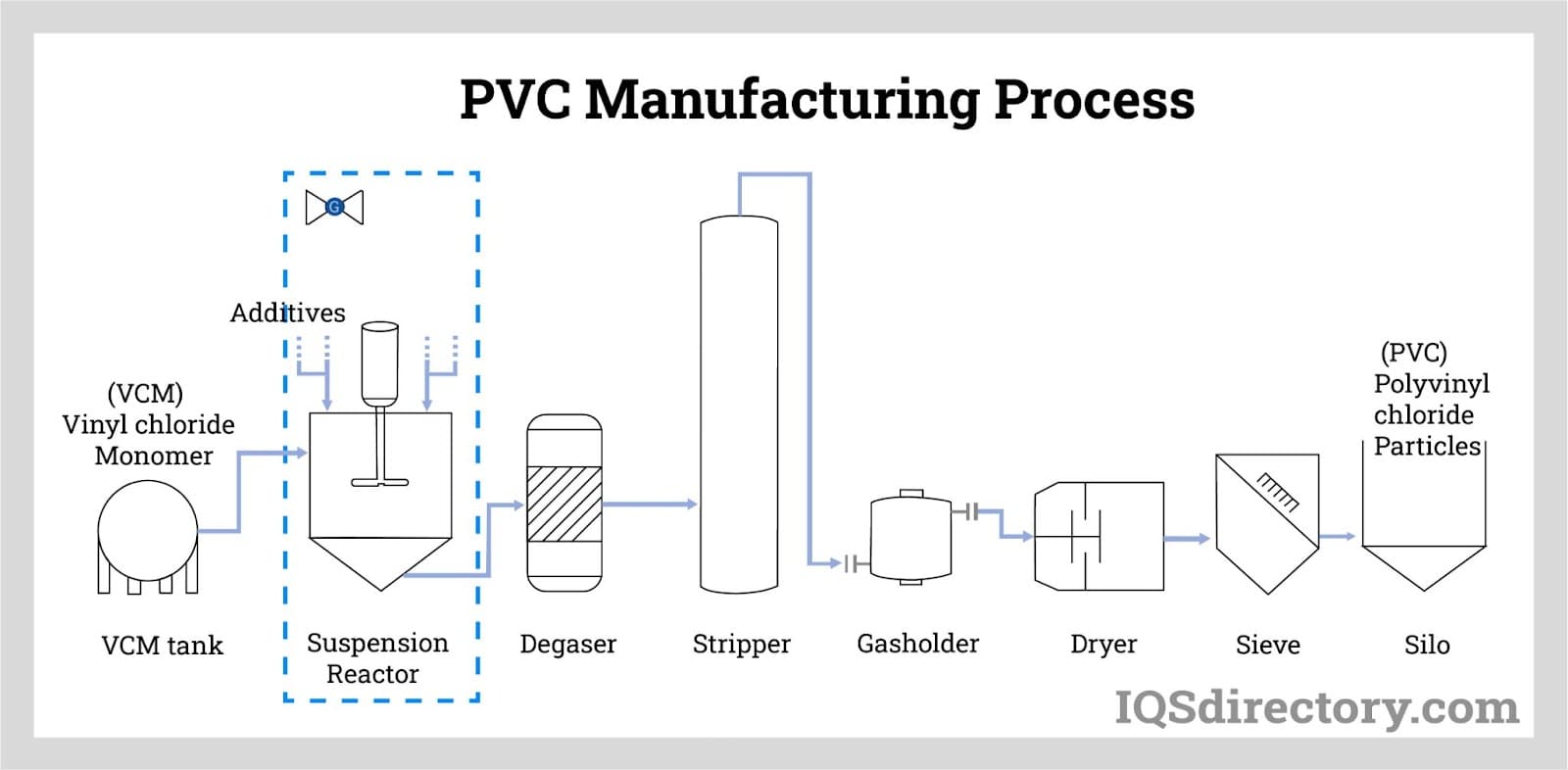
Chlorine is obtained from seawater or salt using electrolysis, adding an extra electron. A powerful electric current passed through a saltwater solution changes its molecular structure, separating the chlorine. When chlorine reacts with ethylene, ethylene dichloride (EDC) is formed. EDC undergoes thermal cracking to yield vinyl chloride monomer (VCM).
VCM enters a reactor with a catalyst to start polymerization, the phase binding vinyl chloride monomers into PVC resin, which forms the base for several vinyl products. PVC naturally appears translucent and is resistant to both chemicals and fire.
To yield vinyl compounds with distinct properties, PVC is combined with various plasticizers, stabilizers, and modifiers. These additives amplify attributes like UV resilience, color retention, abrasion resistance, weatherability, and texture capabilities.
This section outlines the emulsion polymerization technique employed in creating PVC.
In this process, monomer droplets are suspended in water, acting as individual reactors. Aided by an organic catalyst, polymerization begins in a small bulk form. As polymerization progresses, droplets change into sticky, viscous particles.
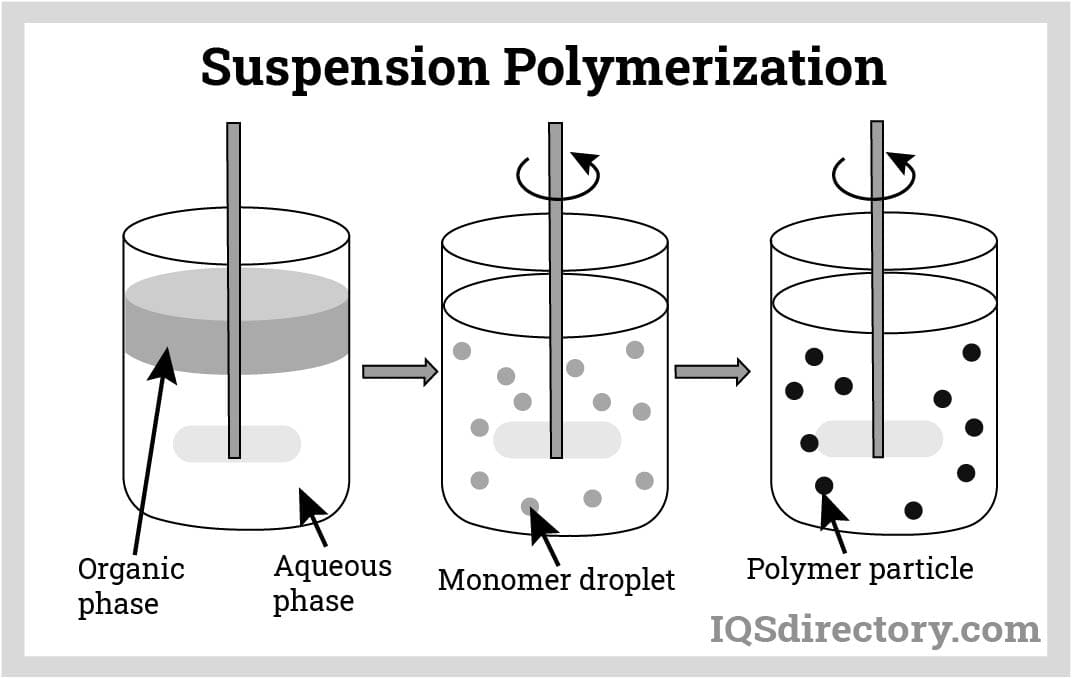
The particles eventually solidify into spherical polymers through vigorous stirring and steric stabilizers. These particles are typically several hundred micrometers in size. Suspension polymerization effectively produces polymers from highly reactive monomers via radical polymerization.
Water aids in the process's agitation and heat transfer. The conversion of monomers keeps the suspension's viscosity relatively steady. Isolated polymer particles are separated from water for further applications. In suspension polymerization, the final polymer particle size distribution (PSD) reflects the monomer droplet size distribution, with minimal shrinkage and mass transfer among particles.
Steric stabilizer type and quantity influence the PSD, which stirring and vessel design also affect. A stable suspension is maintained through controlled agitation and varied stabilizers to achieve desired density, size, and porosity. Two suspension polymerization types exist, including nonporous beads formed when the polymer dissolves in monomers, like PMMA and PS.
Conversely, powders arise when the polymer does not dissolve in the monomer and forms numerous primary particles, presenting opacity and high internal porosity. Porosity control is essential as it influences plasticizer absorption rates, such as with PVC.
Within this method, both monomer solution and initiator are continuously fed into the reactor. Monomer feed, as an oil phase, can be pre-emulsified in water with surfactants, forming an emulsion. Emulsification can occur in a separate or inline vessel using static mixers, ultrasonic devices, or high-pressure systems.
Utilizing a monomer emulsion feed enhances temperature control and process safety while reducing reactor fouling. Achieving over 95% conversion means copolymerization parameters become less critical. Instead, polymer properties align closely with the ratio of monomers fed. Introducing monomers this way allows precise control over particle composition and form by adjusting separate monomer feed rates. A particle seed often regulates number and final size.
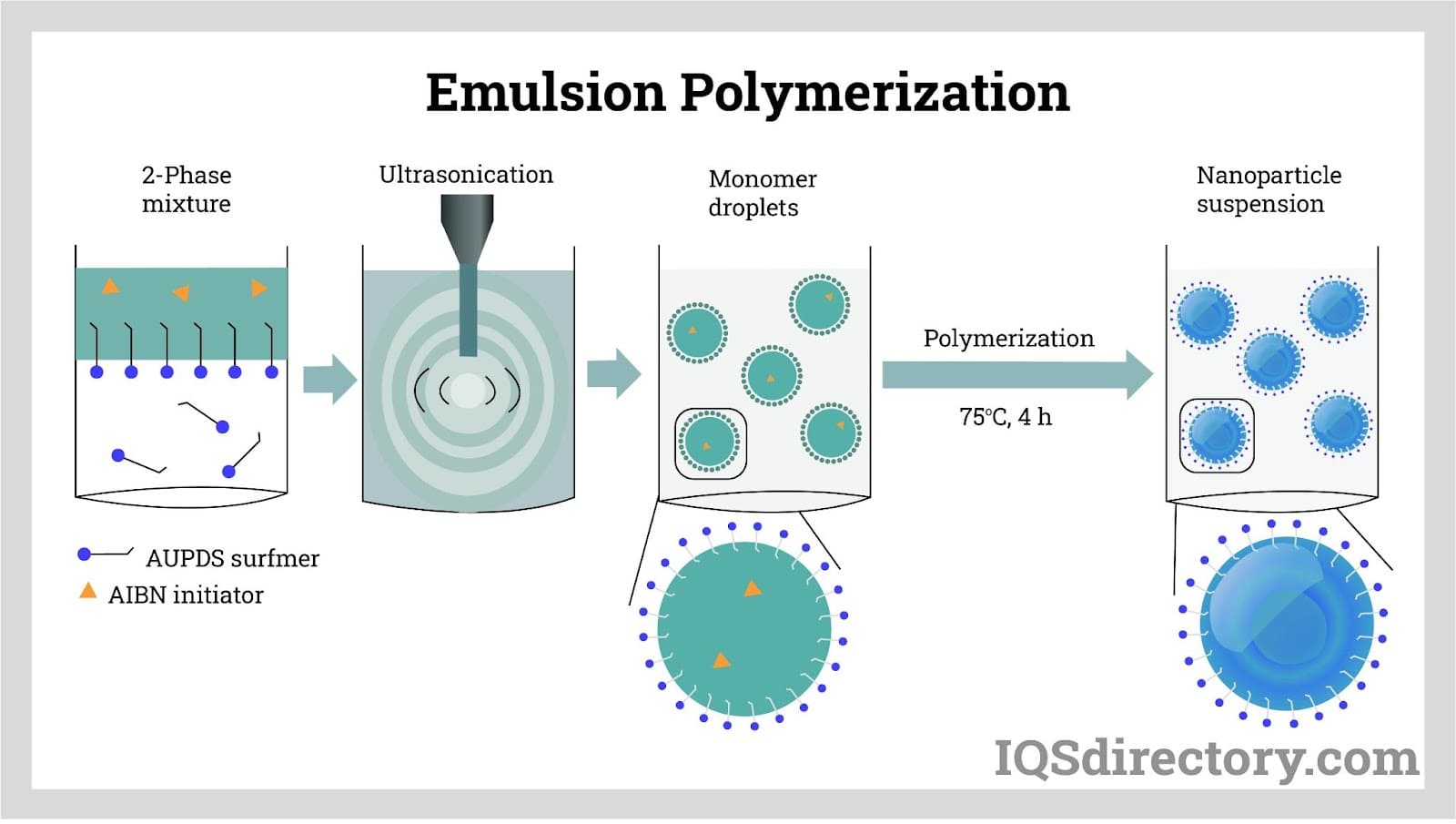
Adding another set of particles introduces either additional seed or sufficiently concentrated surfactant to form micelles, creating a bimodal particle size distribution. This approach achieves high solids content with lower viscosity. Multimodal size distributions may also form via agglomeration agents during emulsion processing.
Incremental cross-linking monomer additions adjust particle morphology. Industrial reactor design and hydrodynamic flow conditions are vital for maintaining stability and efficient heat transfer, with factors like stirrer type and reactor design being significant.
Often labeled mass polymerization, this method foregoes a solvent, using only an initiator and monomer. As polymerization progresses, the polymer molds to the vessel's interior. Managing the heat generated during this process remains a primary challenge.
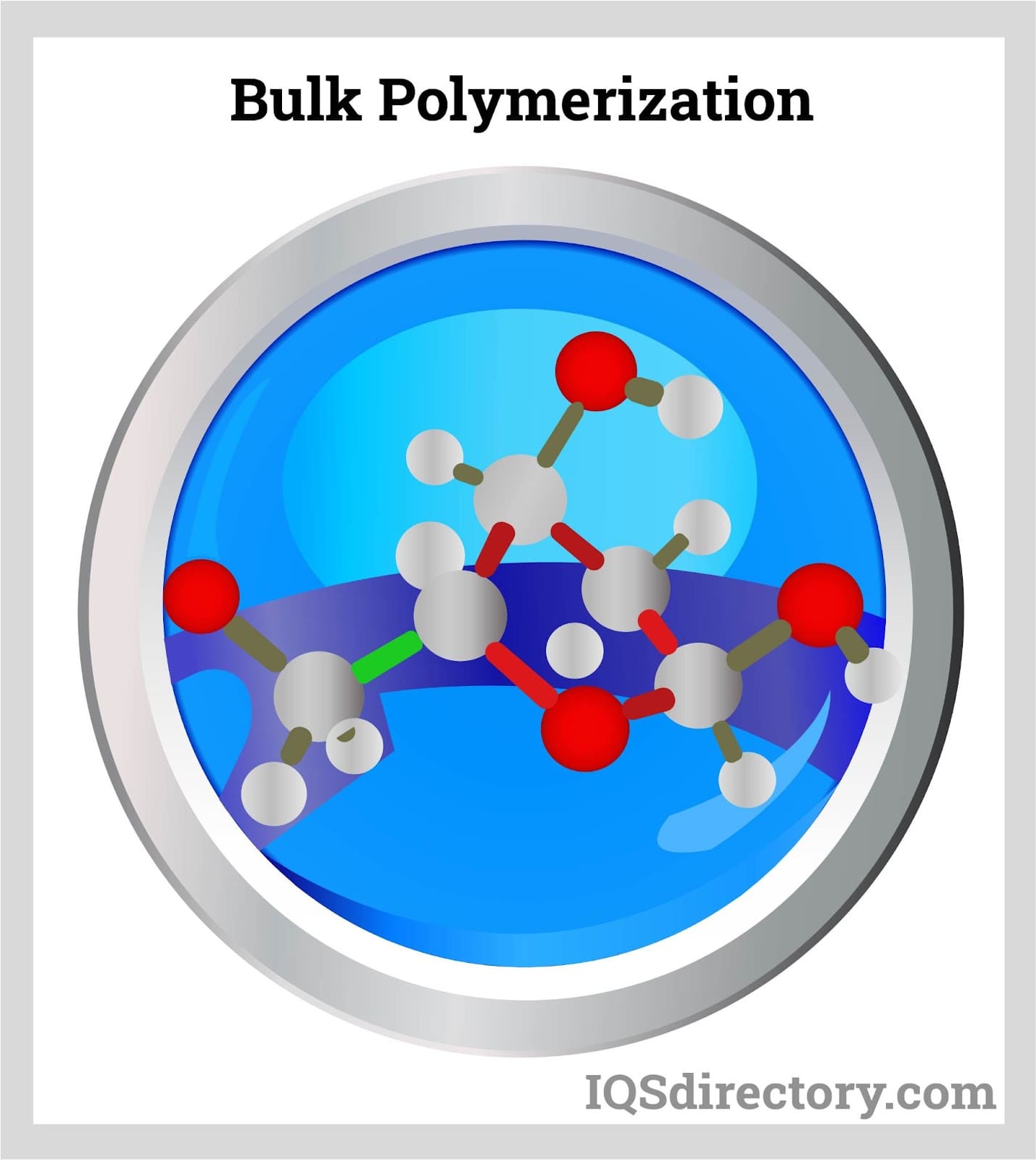
This straightforward approach suits cast-molded items, including polystyrene scintillators. Data suggests distilling the monomer before initiating the reaction to boost polymerization rate. If distillation isn't viable, a suitable solution rinse is advised.
Bulk polymerization's formulation simplicity stems from the exclusion of solvents or dispersants, making it apt for various chain-growth and step-growth polymers. However, exothermic chain-growth reactions can become overly vigorous and challenging without efficient cooling systems in the reactor.
Moreover, bulk polymerizations often present stirring challenges due to the viscosity of high-molecular-weight polymers formed.
In the United States and Canada, manufacturers rely on a diverse range of advanced machinery for the efficient production of PVC tubing. These PVC tube extrusion machines and equipment lines play a vital role in modern plastic manufacturing, facilitating the cost-effective, precise, and high-volume production of PVC pipe and flexible tubing for diverse applications. Industries such as construction (for electrical conduit, irrigation, and plumbing), electronics (insulation and cable management), and automotive (fluid transfer and protective sheathing) all depend on high-quality PVC tubing. To achieve durability, chemical resistance, and exact dimensional tolerances, manufacturers invest in extrusion systems and finishing machinery specifically optimized for PVC polymer processing. The following sections provide an in-depth look at the leading machines and extrusion technologies driving the PVC tubing manufacturing process.
Features: The Conical Twin Screw Extruder is a flagship solution in the global market for PVC extrusion. Known for its energy efficiency and ability to process rigid and flexible PVC compounds, this machine delivers high throughput rates, consistent melt homogeneity, and exceptional plasticizing performance. This translates to greater control over wall thickness, tube diameter, and surface finish—key quality factors in PVC tube production. Additionally, the advanced temperature control systems and easy maintenance features make it a preferred choice for extruding both small-bore and large-diameter PVC pipes and tubing.
Features: KraussMaffei's Single Screw Extruder is widely utilized across North American extrusion facilities for its outstanding versatility and user-friendly operation. It can efficiently process a variety of PVC resin blends and additives, meeting the needs of custom tube sizing and specialty profile shaping. These extruders are ideal for projects requiring variable extrusion speeds, energy-saving modes, and integration with automated downstream equipment such as cooling baths and vacuum calibration units. The result is reliable production of custom-engineered PVC tubing and profiles with excellent mechanical properties and consistency.
Features: Renowned for their robust engineering, Davis-Standard offers a complete suite of downstream equipment critical to PVC tube extrusion lines. Their vacuum sizing tanks ensure tight dimensional control and enhance cooling efficiency, while haul-off units precisely manage tube tension for uniform wall thickness. Automated cutting and coiling systems further improve production speed and minimize material waste. When paired with a high-quality extruder, Davis-Standard equipment enables manufacturers to scale up PVC tube production while maintaining industry standards for smooth finishes and accurate tube geometry.
Features: Bausano Twin Screw Extruders stand out in the PVC tube manufacturing industry for their state-of-the-art screw design and digital process controls. These extrusion machines can handle a broad spectrum of PVC formulations, including medical-grade and high-impact resins. Customers benefit from advanced features such as rapid color change capability, continuous production cycles, and real-time monitoring of output parameters. Bausano’s extruders are often integrated into complete extrusion lines for manufacturing multicavity tubing, corrugated hoses, and reinforced PVC pipes.
Manufacturer: American Kuhne (a division of Graham Engineering Corporation)
Features: American Kuhne specializes in modular extrusion equipment designed for PVC tubing production, from laboratory-scale pilot lines to full-scale industrial systems. Their extruders, precision crossheads, and fully automated downstream equipment support the production of medical, industrial, and custom PVC tube profiles. Customers value their ergonomic machine design, advanced control systems, and strong North American support network. Many manufacturers seeking to optimize PVC tube quality, consistency, and compliance with regulatory standards select American Kuhne systems for their production operations.
To achieve optimal results in PVC tubing manufacturing, companies often evaluate several factors beyond just machine model, such as extrusion speed, energy consumption, ease of maintenance, machine automation level, and the compatibility of equipment with specific PVC formulations. Key user intent includes seeking low-cost, high-quality, and flexible production solutions that enable fast product changeovers, reduced downtime, and compliance with industry standards like ASTM and CSA. If you are considering upgrading your PVC tube extrusion line or starting new production, it is recommended to assess the latest advancements in screw technology, in-line quality monitoring systems, and integration with digital manufacturing platforms (Industry 4.0). For up-to-date technical specifications, new model releases, and best practices in PVC tube production, consult industry trade publications or contact manufacturers, suppliers, and experts directly.
This section explores the main types of PVC (polyvinyl chloride) pipes and products, their unique material characteristics, and the specialized additives that enhance their performance across a range of industrial, commercial, and residential applications.
The major types of PVC pipes and products include:
If a pipe is labeled with an additional 'U' at the end, it signifies unplasticized PVC (PVC-U), the most common and widely used PVC variant for industrial and plumbing applications. This material omits plasticizers—additives designed to boost plasticity and flexibility and minimize brittleness. As a result, PVC-U is also called rigid PVC tubing.
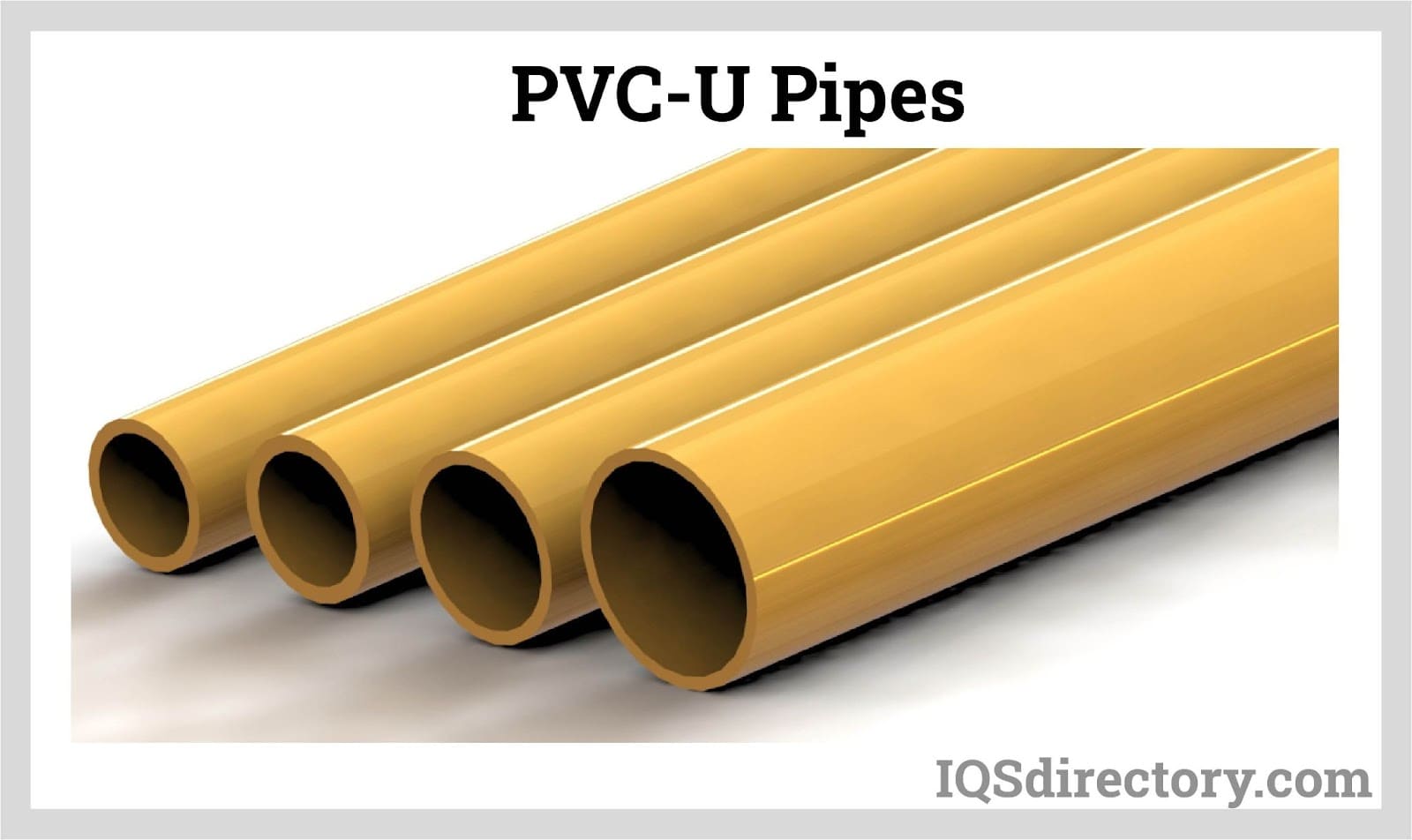
Unplasticized PVC (PVC-U) is the top material choice for manufacturing pipes and fittings in potable water distribution, sewage, and drainage systems. Its inherent advantages—ease of handling, lightweight construction, affordability, chemical resistance, and impressive mechanical strength—make it a popular solution in building and infrastructure projects. Moreover, the recyclability of rigid PVC pipe supports industry initiatives toward sustainable construction practices and circular economy goals. PVC-U pipes also showcase resistance to corrosion, protecting pipework and reducing maintenance needs.
PVC-O, or oriented PVC, is produced via a molecular orientation process, which transforms regular PVC-U into a layered, highly organized structure. This process dramatically boosts the pipe’s durability, flexibility, and resistance to internal pressure as well as environmental stress cracking and corrosive substances.
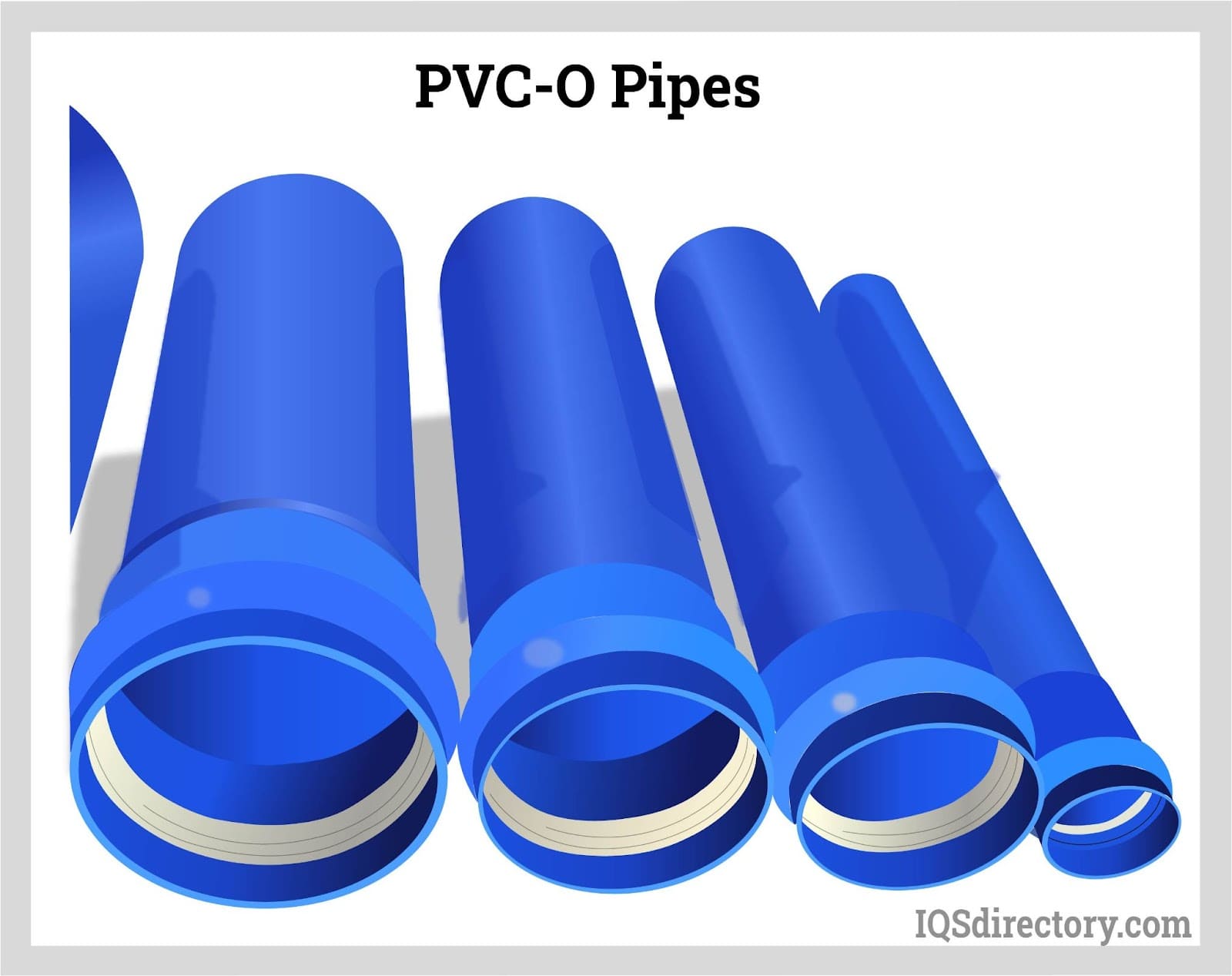
PVC-O pipes deliver a unique combination of stiffness, tensile strength, and flexibility, which translates into superior hydraulic capacity and long service life. These enhanced physical and mechanical properties make oriented PVC pipes ideal for pressure pipe applications such as large-scale irrigation systems, potable water transmission, sewer pumping mains, and industrial fluid handling, where efficiency, reliability, and cost-effectiveness are priorities. PVC-O's lightweight nature also reduces installation and transport costs compared to traditional piping materials.
C-PVC (chlorinated polyvinyl chloride) is a PVC variant processed with chlorine, which enhances its ability to handle hot water and resist aggressive chemicals without compromising structural integrity. C-PVC shares the core features of PVC-U—such as low cost, smooth interior surfaces, and ease of joining—while expanding application possibilities.
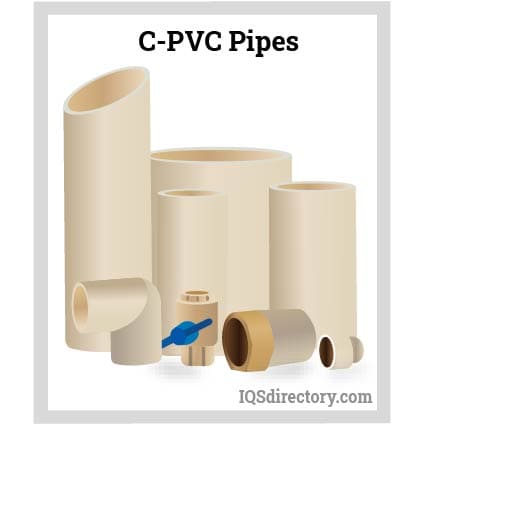
Thanks to its elevated temperature resistance and excellent corrosion protection, C-PVC piping is widely used for potable hot and cold water supply lines, fire sprinkler systems, and industrial plumbing in both residential and commercial construction. The chlorination process supplies C-PVC with the extra rigidity and performance needed for harsh or high-temperature water and chemical processing environments.
PVC-Hi, or high-impact PVC pipes, are engineered by modifying standard PVC compositions with advanced impact modifiers, raising their resilience to external shock and rough handling. The specialized compound blend enhances durability under demanding, high-pressure conditions while ensuring long-term tensile strength and minimal deformation.
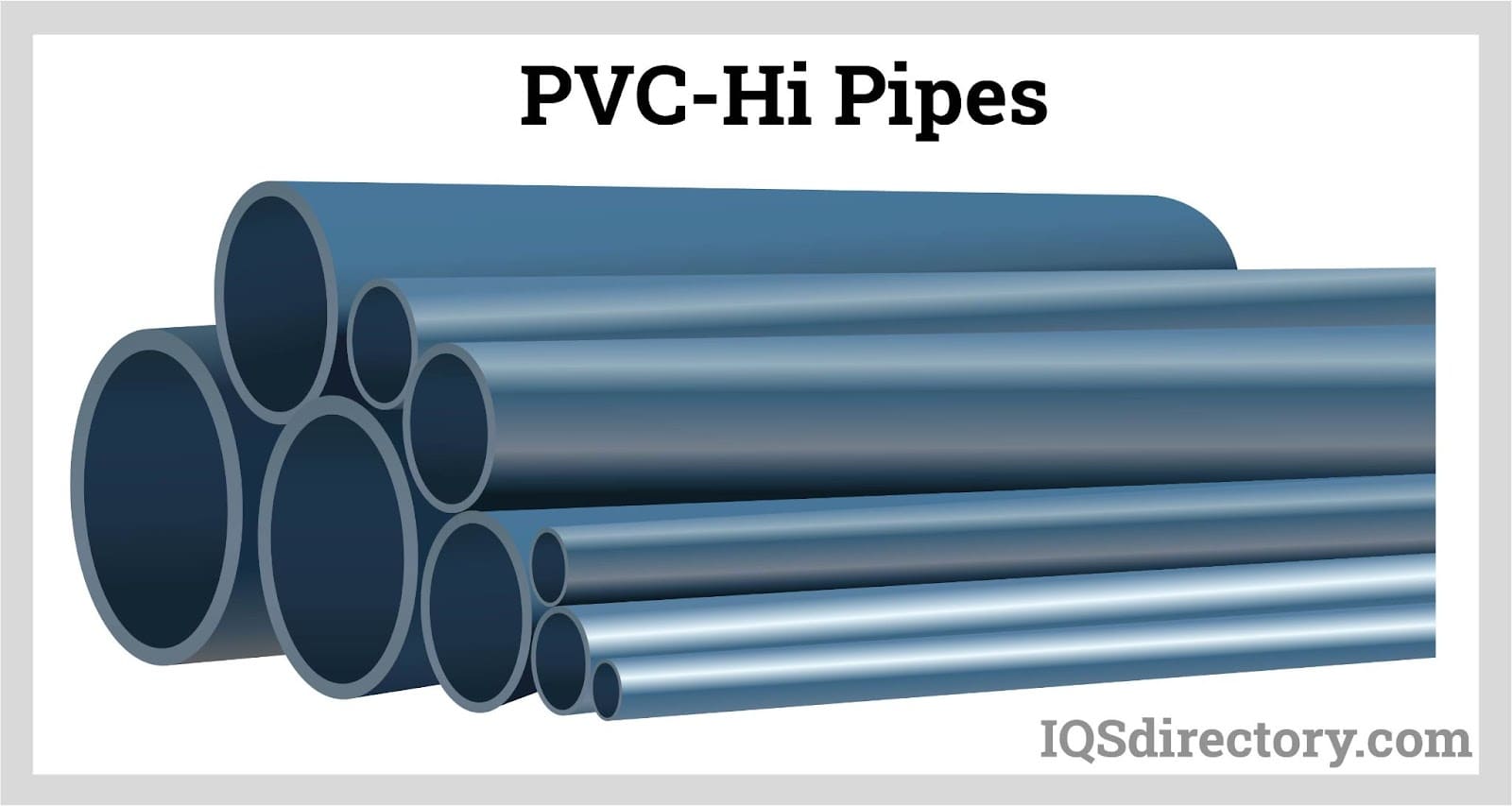
High-impact PVC pipe is specifically engineered to meet strict regulatory and safety requirements. It is a preferred option for transporting natural gas, highly pressurized liquids, and hazardous fluids, where pipe integrity is critical for safety and code compliance. Pipes classified as PVC-Hi must comply with rigorous standards for mechanical strength, impact resistance, and long service life, ensuring reliable performance in utility, industrial, and energy infrastructure projects.
PVC cables are electrical wires insulated with a durable polyvinyl chloride sheath. Renowned for their longevity, thin cross-section, fire retardancy, and resistance to abrasion, PVC cables withstand a wide range of environmental stressors and operating conditions.
These cables are highly valued in the electrical and construction sectors for their longevity and flexibility. Their robust construction makes them resistant to weather, chemicals, moisture, and cracking from exposure to sunlight or aging. Featuring a high dielectric strength, PVC-insulated wires provide reliable insulation for domestic appliance wiring, internal electrical circuits, power distribution, telecommunications, and control panels in industrial facilities.

PVC’s flexibility allows manufacturers to design a variety of cable types—ranging from standard household wire and multicore cables to underground wiring—making it essential to select the right grade for each specific use case. Eco-friendly advances, such as low-smoke, halogen-free cables, further extend PVC’s relevance in green building and safety-conscious environments.
PVC siding, also called vinyl siding, is a durable, synthetic exterior cladding solution widely adopted in residential and light commercial buildings. Like other PVC-based construction materials, PVC siding is long-lasting, energy efficient, highly weather-resistant, and delivers substantial cost savings during installation and lifecycle maintenance.
Superior airtight insulation and seamless panel interlock design prevent air infiltration and water ingress, reducing the risk of mold, drafts, and water damage common with conventional materials like wood. The maintenance-free PVC siding never needs repainting or refinishing, and only occasional cleaning is required to maintain its pristine, fade-resistant finish. Its outstanding longevity, resistance to cracking or peeling, and broad selection of colors and textures make it the preferred exterior cladding in modern and sustainable building design.
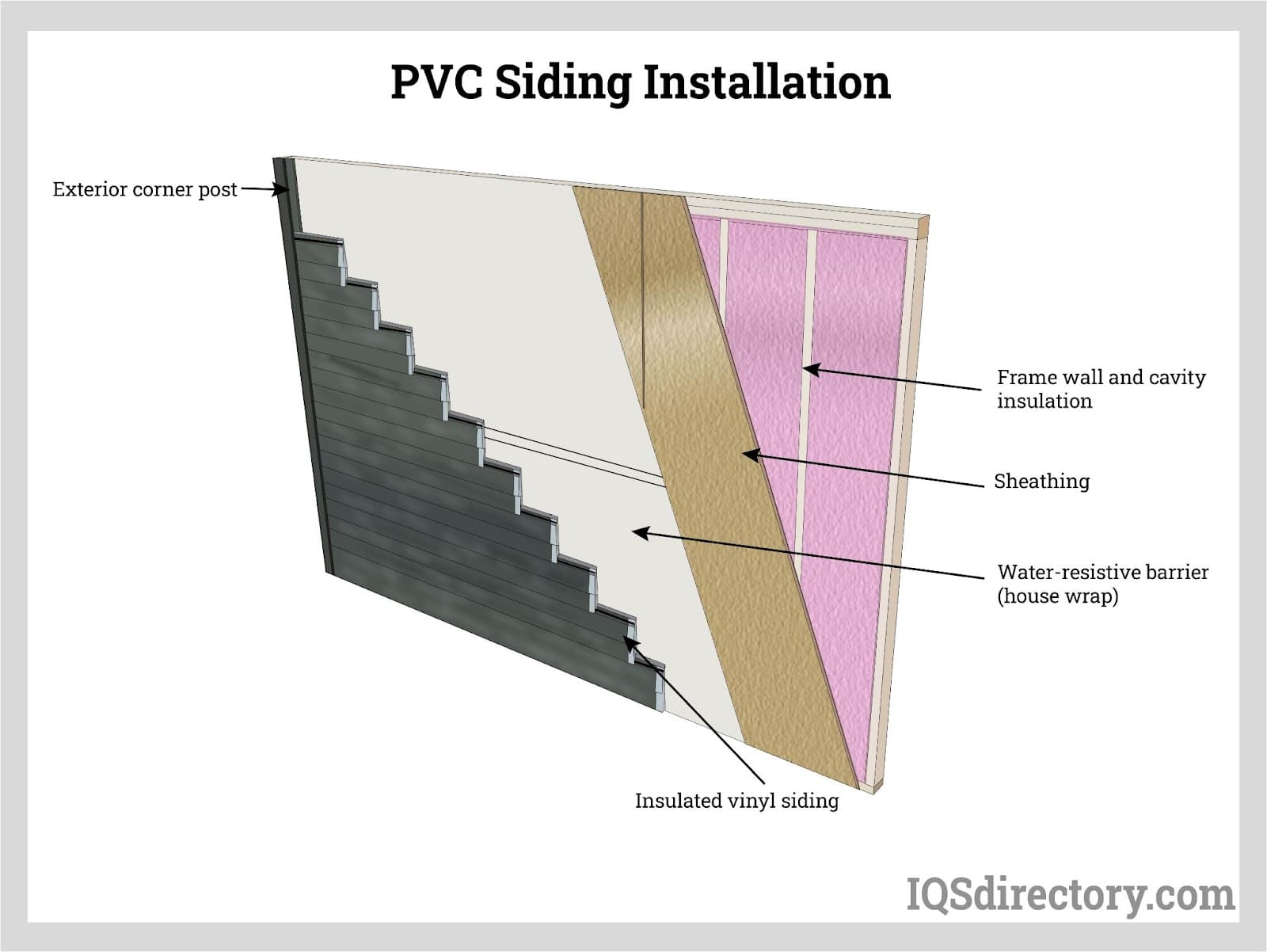
PVC packaging materials are widely used for their versatility, transparency, lightweight composition, and ability to create a secure, airtight seal. Packaging films, containers, and blister packs made from PVC are safe for contact with food and pharmaceuticals, as they do not alter taste or chemical properties of the contents and help extend shelf life by acting as barriers to oxygen, moisture, and contaminants.
In medical and food packaging industries, transparent PVC containers and blister packs ensure both product security and tamper evidence. Medical facilities utilize PVC packaging for safe, sterile storage and disposal of items like syringes, gloves, vials, and other disposable medical devices. For additional security, blister packages for pharmaceutical products are made from medical-grade PVC, providing tamper resistance and supporting compliance with rigorous safety regulations. Modern PVC packaging also uses food-safe additives to maintain product quality while supporting efficient manufacturing and recycling processes.
PVC's broad applicability and customizability make it a principal material in the manufacture of home goods and everyday consumer products. From flexible PVC for shower curtains, rainwear, and inflatable furniture to rigid PVC used in flooring, wall coverings, and furniture, this polymer’s unique balance of durability and flexibility enables production of high-performance consumer products at affordable costs.
Among common household uses are protective clothing, kitchenware (bowls, utensils), toys, water hoses, food storage containers, pet products, tarps, tents, and even home improvement items such as window and door frames. PVC’s chemical stability and weather resistance ensure long product life with minimal wear or discoloration—an essential benefit for products exposed to moisture or sunlight. Advances in PVC manufacturing technologies now allow for increased energy efficiency, ease of recycling, and the creation of designer styles and color options for virtually every living space.
The items highlighted here represent a sample of the extensive array of PVC-based goods contributing to modern lifestyles. As research and development progress, PVC continues to play a vital role in innovative home product solutions, enhancing everyday convenience and safety.
PVC is a robust, lightweight thermoplastic valued for its durability, flame retardancy, chemical resistance, and low cost. Its adaptability to various additives allows it to serve roles in construction, electronics, and household goods, making it one of the most commonly used plastics globally.
PVC is produced mainly from salt (57%) and hydrocarbon feedstocks (43%). The process involves extracting ethylene and chlorine, synthesizing vinyl chloride monomer, polymerizing it into PVC resin, then blending with additives to achieve specific properties.
PVC is produced via suspension, emulsion, and bulk polymerization methods. Suspension polymerization uses water and monomer droplets, emulsion relies on surfactants and controlled feed rates, and bulk omits solvents, using only monomer and initiator.
Leading models include Battenfeld-Cincinnati Conical Twin Screw Extruder, KraussMaffei Single Screw Extruder, Davis-Standard Downstream Equipment, Bausano Twin Screw Extruders, and American Kuhne Extrusion Equipment—each offering advanced controls, quality, and automation for diverse PVC tube applications.
Major PVC pipe types include PVC-U (unplasticized), PVC-O (oriented), C-PVC (chlorinated), and PVC-Hi (high-impact). They serve potable water, sewage, irrigation, chemical transport, and high-pressure fluid applications, offering strength, flexibility, and corrosion resistance.
PVC uses abundant salt and can employ bio-sourced ethylene from sugar crops, reducing dependence on oil compared to most thermoplastics. Some regions even substitute oil-based hydrocarbons completely, favoring renewable alternatives for production.
Clear PVC is valuable for monitoring system operations in real-time, making it essential for laboratories, product manufacturing, and production environments. It is particularly important in clean room settings, where continuous visibility of processes is crucial for maintaining the room’s integrity.
Like other forms of PVC, clear PVC is resistant to corrosion, enabling it to withstand acids, bases, and other corrosive substances. Its smooth interior surfaces facilitate the unobstructed flow of materials, preventing sediment buildup. Clear PVC is also well-suited for medical and sterile environments due to its resistance to bacterial and biological growth.
Standard PVC is a transparent, amorphous thermoplastic, while CPVC (Chlorinated Polyvinyl Chloride) offers excellent mechanical strength and impact resistance with clear visibility. CPVC is also formulated to resist UV radiation, making it suitable for exterior applications.
Clear PVC is produced through the chlorination of PVC polymer, increasing the chlorine content to 66%. This process reduces the attraction between molecular chains, making the material more flexible and easier to stretch. In CPVC, about 40% of the bonding sites are occupied by chlorine atoms, which are large and provide protection to the polymer chain.
Batching is a crucial step in manufacturing clear PVC. It involves precisely formulating the PVC resin along with plasticizers, stabilizers, and other additives. Accurate measurement and control of these components are essential, as any deviations can adversely affect the final product. The batching process results in pellets or powder, which are then used for further processing.
Chlorination modifies the properties of PVC to produce clear PVC. This involves exposing the PVC material to a controlled amount of chlorine gas. For clear PVC, chlorination improves its resistance to high temperatures and chemicals. During this process, chlorine gas reacts with the PVC, integrating chlorine atoms into the polymer chain.
In the extrusion process, the powder or pellets from chlorination are fed into an extruder's hopper. As these materials are moved through the extruder barrel by a screw, they are heated and melted before being forced through a die under pressure. This process is used to create clear profiles and tubing.
Calendaring is used to produce sheets of clear PVC. The PVC powder is heated until it becomes soft and pliable. It is then passed through rollers that compress, flatten, and shape the material into sheets of various thicknesses, ranging from a fraction of an inch to several inches.
Clear PVC's strength and durability extend its applications beyond medical and research uses. The increased strength provided by the chlorination process makes clear PVC suitable for a range of industrial applications, demonstrating its versatility and importance in various fields.
Clear PVC's popularity has surged as its applications continue to expand. Its unique properties and characteristics make it an excellent alternative to metal in critical applications. Its versatility, combined with its strength and durability, makes it a preferred material for various demanding uses.
Clear PVC’s physical properties, characteristics, and specifications make it an ideal choice for applications in chemical processing, mineral processing, and handling hazardous materials. Its durability and reliability ensure effective performance in harsh and demanding industrial environments.
PVC is produced in two primary forms: rigid or unplasticized PVC (RPVC or uPVC) and flexible plasticized PVC. In its natural state, PVC is rigid and brittle, requiring enhancement through various additives and stabilizers to improve its properties.
Rigid PVC is commonly used in applications such as sewage disposal, agriculture, and plumbing due to its strength and durability. In contrast, plasticized PVC is made more flexible and softer by adding plasticizers like phthalates (e.g., diisononyl phthalate or DINP). This flexibility makes plasticized PVC suitable for uses such as electrical wire insulation and flooring in hospitals, schools, and other environments where sterility is important. It is sometimes used as an alternative to rubber. Unplasticized PVC is frequently employed in construction, particularly for plumbing pipes and siding.
Rigid PVC does not include phthalates, which are chemicals used to enhance flexibility in PVC products. When PVC lacks phthalates, it is referred to as uPVC or rigid PVC. This type of PVC is often used for water containers and building materials, and it is known for its fade resistance, with color extending throughout its thickness.
uPVC has a broad range of applications and is commonly used as a construction material and as a replacement for copper and aluminum piping in waste systems, irrigation, and pool circulation. Its ease of forming and cutting makes it a practical alternative to metal products.
PVC and CPVC differ significantly in their temperature tolerance. CPVC can withstand temperatures up to 200 degrees Fahrenheit, whereas PVC is suitable for temperatures up to 140 degrees Fahrenheit.
Exceeding these temperature limits causes both PVC and CPVC to soften, increasing the risk of joint failure and compromising the integrity of the plumbing system. Additionally, due to their distinct chemical compositions, the bonding agents, solvent cements, and primers used for CPVC and PVC are not interchangeable.
PVC is known for its high density relative to most other plastics, making it both readily available and cost-effective. Unplasticized rigid PVC is particularly noted for its hardness and durability, and it offers excellent tensile strength. As a thermoplastic, PVC behaves similarly to other plastics when exposed to heat: it melts and becomes a liquid at its melting point.
PVC has a range of melting points from 100 degrees Celsius to higher values like 260 degrees Celsius depending on the types of additives. Thermoplastics can be heated until they reach their melting point, cooled, and reheated again without any significant degradation. Instead of burning, thermoplastics such as propylene liquefy allows them to be injection molded in an easy way and then recycled subsequently.
In contrast, thermosetting plastics can only be heated once, typically during the injection molding process. During this initial heating, thermosets undergo a chemical change that sets their structure irreversibly. If a thermoset material is reheated, it simply burns rather than melting. This property limits the recyclability of thermoset materials.
The fundamental chemical structure of PVC is outlined below.
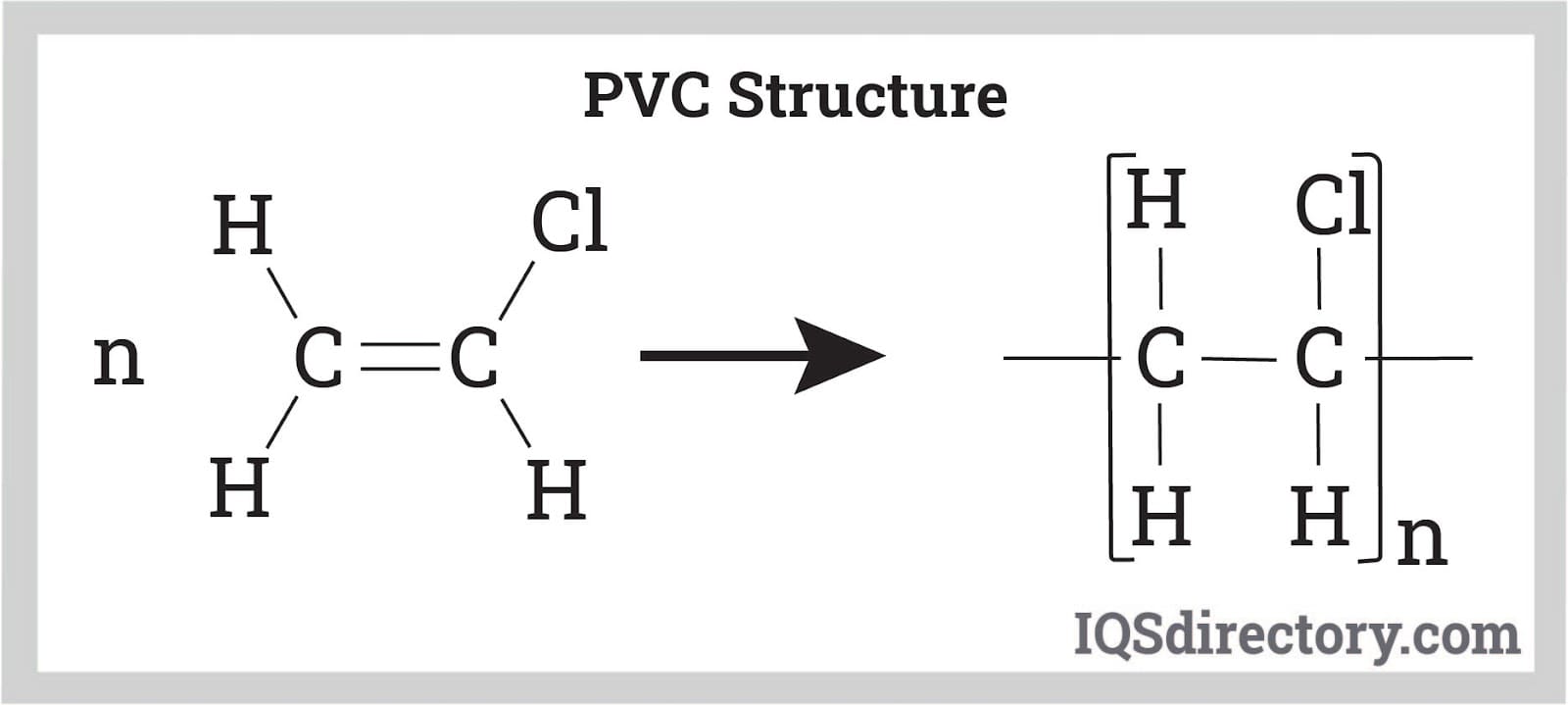
PVC, or polyvinyl chloride, has the chemical formula (C2H3Cl)n. It contains more than 50% chlorine by weight.
Various additives used in PVC include:
Lubricants are utilized for the reduction of friction during processing. External lubricants can reduce friction between the polymer and the equipment for processing, whereas internal lubricants work on the granules of the polymer (PVC).
Flexible PVC applications, such as extruded profiles, injection-molded soles, and calendered films, commonly use liquid mixed metal stabilizers. These stabilizers are primarily composed of zinc, barium, and carboxylates.
For optimal performance, co-stabilizers, antioxidants, and organophosphates are often required in liquid mixed metal systems like CaZn and BaZn. Cadmium-based stabilizers have largely been replaced by BaZn stabilizers due to their effectiveness and environmental benefits.
Heat stabilizers are crucial in PVC formulations to prevent decomposition caused by heat and shear during processing. They also enhance PVC's resistance to sunlight, thermal aging, and weathering. Additionally, heat stabilizers significantly impact the physical properties and cost of the PVC formulation. The selection of a heat stabilizer depends on several factors, including the technical specifications of the polymer product, cost considerations, and regulatory compliance.

A plasticizer is an additive used in polymers to enhance flexibility, resilience, and workability. The selection of plasticizers is guided by the desired properties of the final product and its intended application. There are over 300 different plasticizers available, with approximately 50 to 100 commonly used in commercial applications. Phthalates are among the most frequently used plasticizers, and they can be categorized into distinct groups based on their specific uses and chemical classes.
Low molecular weight phthalates, which contain eight or fewer carbon atoms in their chemical structure, include DBP, BBP, DIBP, and DEHP. These phthalates are typically used in a limited range of specific applications due to their properties and regulatory considerations.
High molecular weight phthalates, which contain 7 to 13 carbon atoms in their chemical structure, include DPHP, DTDP, DIUP, DIDP, and DINP. These phthalates are commonly used in various applications, such as cables and flooring, where they provide durability and flexibility.
Specialty plasticizers, such as adipates, benzoates, citrates, and trimellitates, are employed when specific physical properties are required. These may include enhanced flexibility at low temperatures or other unique characteristics tailored to particular applications.
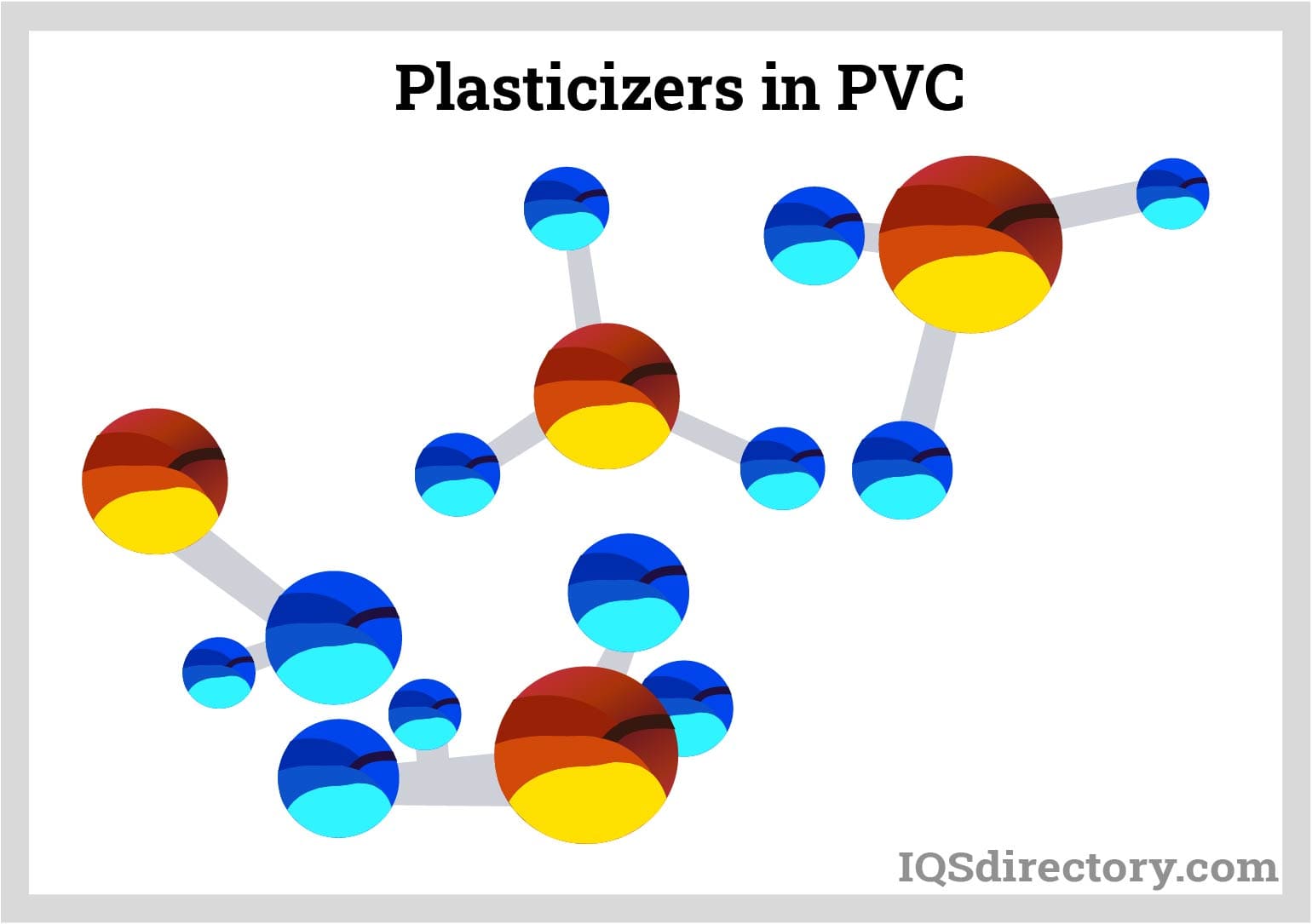
Many of the PVC products that are used everyday but tend to be taken for granted consist of phthalate plasticizers. They include blood bags, electrical cables, footwear, stationery, toys, and medical tubing. Phthalates are utilized in other non-PVC applications like rubber products, paints, adhesives, and some cosmetics.
While not essential for maintaining the plastic's structural integrity, optional additives are used to impart additional properties. These include impact modifiers, processing aids, nitrile rubbers, filters, flame retardants, pigments, and colorants.
This chapter will explore the benefits of PVC, including its various applications and the processes involved in recycling it.
Despite its many advantages, PVC also has some drawbacks, including:
Despite its drawbacks, the advantages of PVC are significant and numerous. Here’s a closer look at its benefits:
PVC excels in electrical insulation, making it a top choice for cabling applications. It is also known for its strong impact resistance and weather durability, which make it ideal for construction materials. Additionally, PVC is widely approved for use in medical and food contact applications due to its safety and reliability.
Processing PVC is efficient and requires less energy compared to many other plastics. The material is lightweight yet durable, contributing to its long lifespan.
Another key advantage of PVC is its clarity and neutral taste properties, which make it a preferred material for packaging, as it does not alter the flavor of food products.
Furthermore, PVC has a relatively low carbon footprint. For example, PVC windows can contribute to lower energy bills. The material is fully recyclable and can be easily repurposed into new products, supporting sustainable practices.
PVC pipes offer numerous advantages, including exceptional durability and cost-effectiveness. These benefits make them a highly favorable choice. Below are additional advantages of using PVC pipes:
PVC pipes are highly effective for transporting drinking water due to their resistance to corrosion, which inhibits bacterial growth. This property makes PVC an excellent barrier against contaminants, ensuring safer drinking water for the public.
PVC is a low-carbon plastic, which means it requires fewer resources and less energy to produce compared to other materials. Its lightweight nature simplifies packaging and shipping, and its smooth surface reduces pumping costs, further lowering energy consumption. Additionally, PVC is both recyclable and sustainable.
PVC can be recycled up to seven times while maintaining its properties. Recycling PVC helps conserve natural resources and reduces carbon dioxide emissions, with each kilogram of recycled PVC saving approximately two kilograms of CO2. This makes PVC a highly eco-friendly material, contributing to environmental protection and reducing landfill waste.
Modern industries benefit from PVC's durability and low maintenance requirements. PVC pipes are lightweight yet robust, with a lifespan extending for decades under various conditions. This durability, coupled with lower installation and operating costs, makes PVC a cost-effective choice that requires minimal upkeep.
PVC is widely used in various applications, including:
PVC is utilized in a range of construction applications due to its strength, durability, and versatility. It is particularly well-suited for window profiles and cabling, thanks to its excellent insulation and flame-retardant properties.
Examples of PVC construction products include:
PVC plays a crucial role in numerous life-saving and healthcare applications. Its cost efficiency and exceptional performance make it ideal for use in surgical instruments, drug delivery systems, pharmaceuticals, and medical packaging. PVC’s reliability and versatility contribute significantly to advancements in medical care and treatment.

Examples of PVC healthcare products include:
PVC is widely used as insulation for cables because it is easy to handle during installation, offers flexibility, and has inherent flame retardant properties. PVC cables are known for their strength and longevity, resisting hardening and cracking over time. These characteristics make PVC cables ideal for various applications, including telecommunications and electric blankets.
Here are some common automotive applications for PVC:
PVC's environmental benefits and versatility make it a popular choice in construction, particularly for sporting venues. It is used extensively in roofing, seating, flooring, and electrical wiring and piping. Additionally, PVC is found in various athletic gear, from shoes and clothing to equipment and competition surfaces.
The inherent structure and composition of PVC facilitate its mechanical recycling, allowing for the production of high-quality recycled materials. Proper sorting of PVC is crucial during recycling. The PVC industry has heavily invested in developing advanced recycling technologies to ensure that significant quantities of PVC are repurposed into new, innovative products that are energy-efficient and sustainable.

This investment has enabled the recycling of not only production off-cuts but also end-of-life products such as PVC-U windows and doors on a large global scale. Recycling old windows is more complex than recycling off-cuts due to the need to remove contaminants like building debris before re-processing.
Polyvinyl chloride (PVC) is a tough synthetic polymer that exists in two forms which are plasticized and unplasticized PVC. Plasticized PVC has more plasticity, flexibility, and it’s softer due to the presence of a plasticizer. Many types of plasticizers are available that result in the polymer (PVC) having a variety of properties when added to it. Different PVC products are available with different properties depending on the type of PVC used. It is important to take note of the properties of the type of PVC used in the product that one can purchase for a certain application. To add on, PVC is a material that is long lasting, cheap and it can be applied with greater ease, for example in the electrical field where it is used as insulation for cables. PVC has a great diversity of applications, including floor and wall covering, making doors and windows, sewer pipes, water transport pipes, and natural gas transport pipes.

An industrial hose is a durable and precision constructed hose used to transfer and transport liquids, gases, and other materials for industrial applications. They are made of materials that...
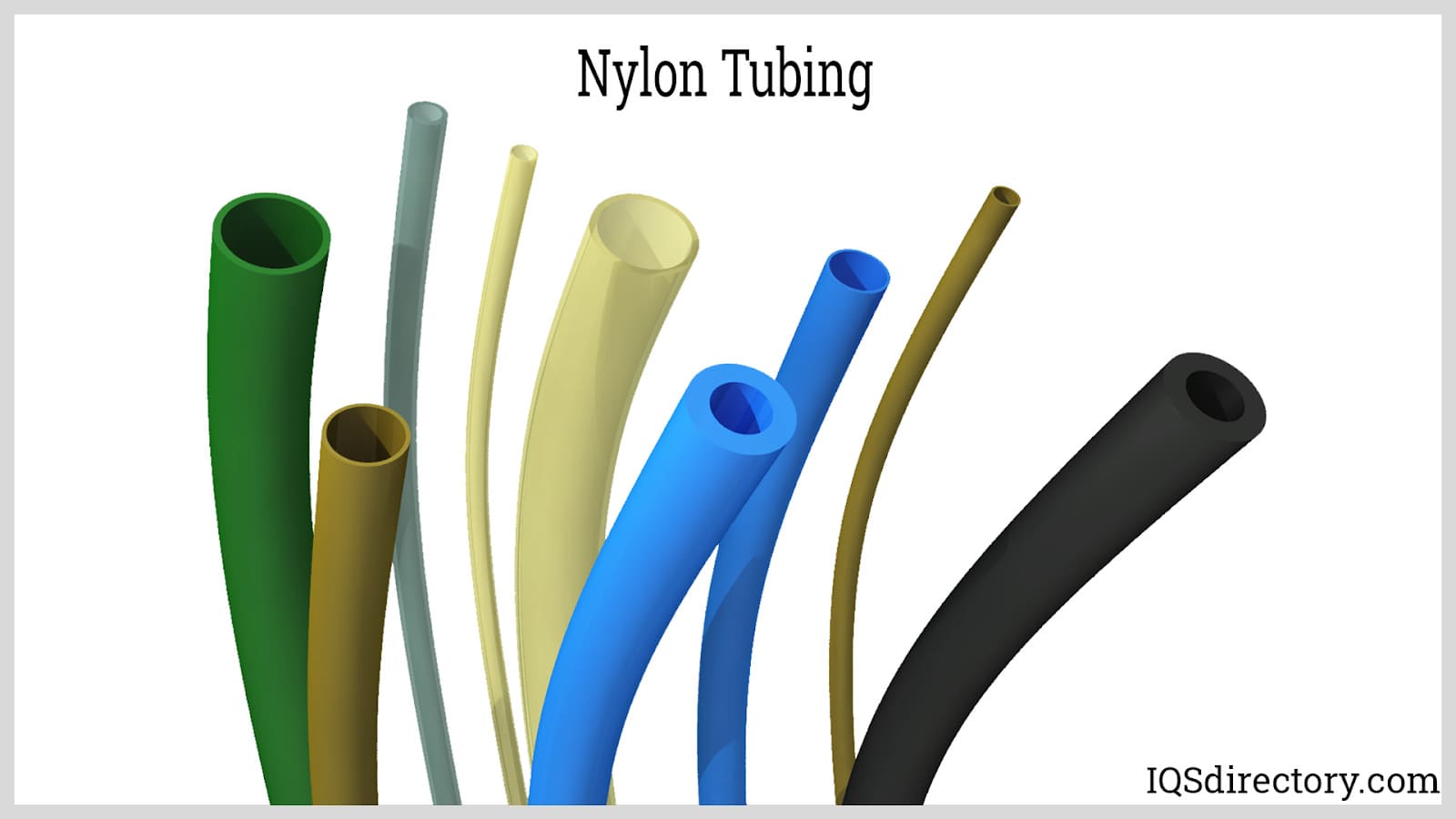
Nylon tubing, also known as polyamide tubing, is a type of tubing made from polyamide resin, which has a strongresistance to abrasion. It is used in high-pressure and high-temperature applications...
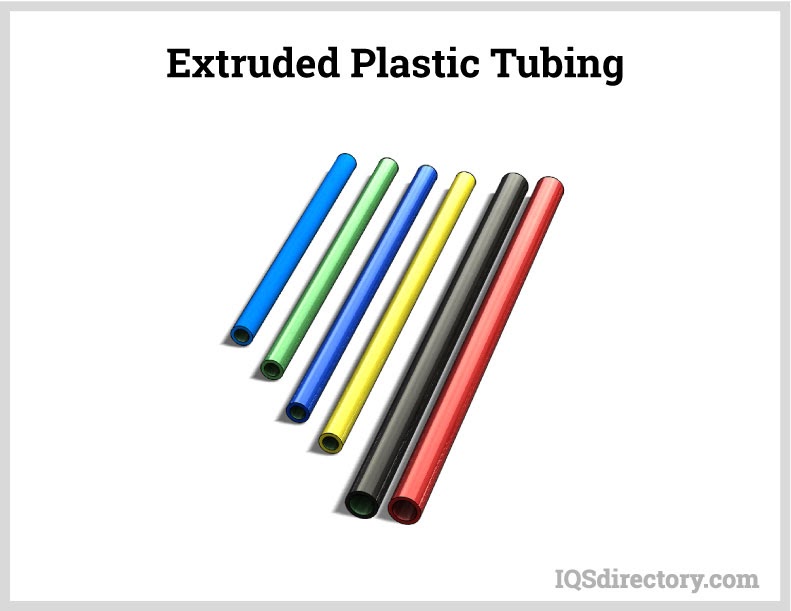
Plastic tubing is a form of tubing that is manufactured from a mixture of a polymer with a variety of chemicals to form a material that can be solid or flexible. Since its first use in...
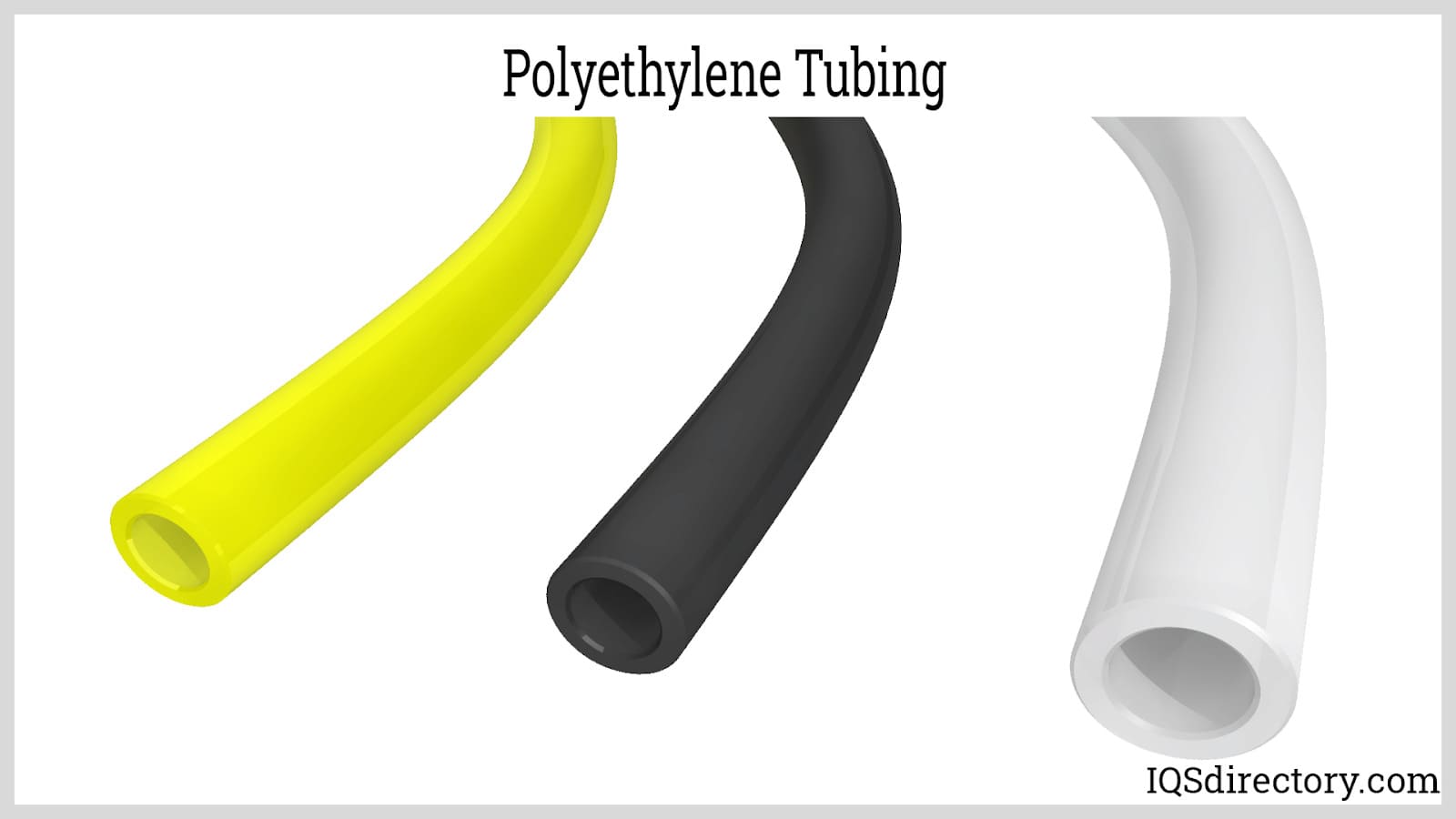
Poly tubing is a highly flexible, lightweight, and durable tubing that is produced from polyethylene, a polymer that is made from the polymerization of ethylene. It is a very versatile form of tubing that has break and crack resistant walls...
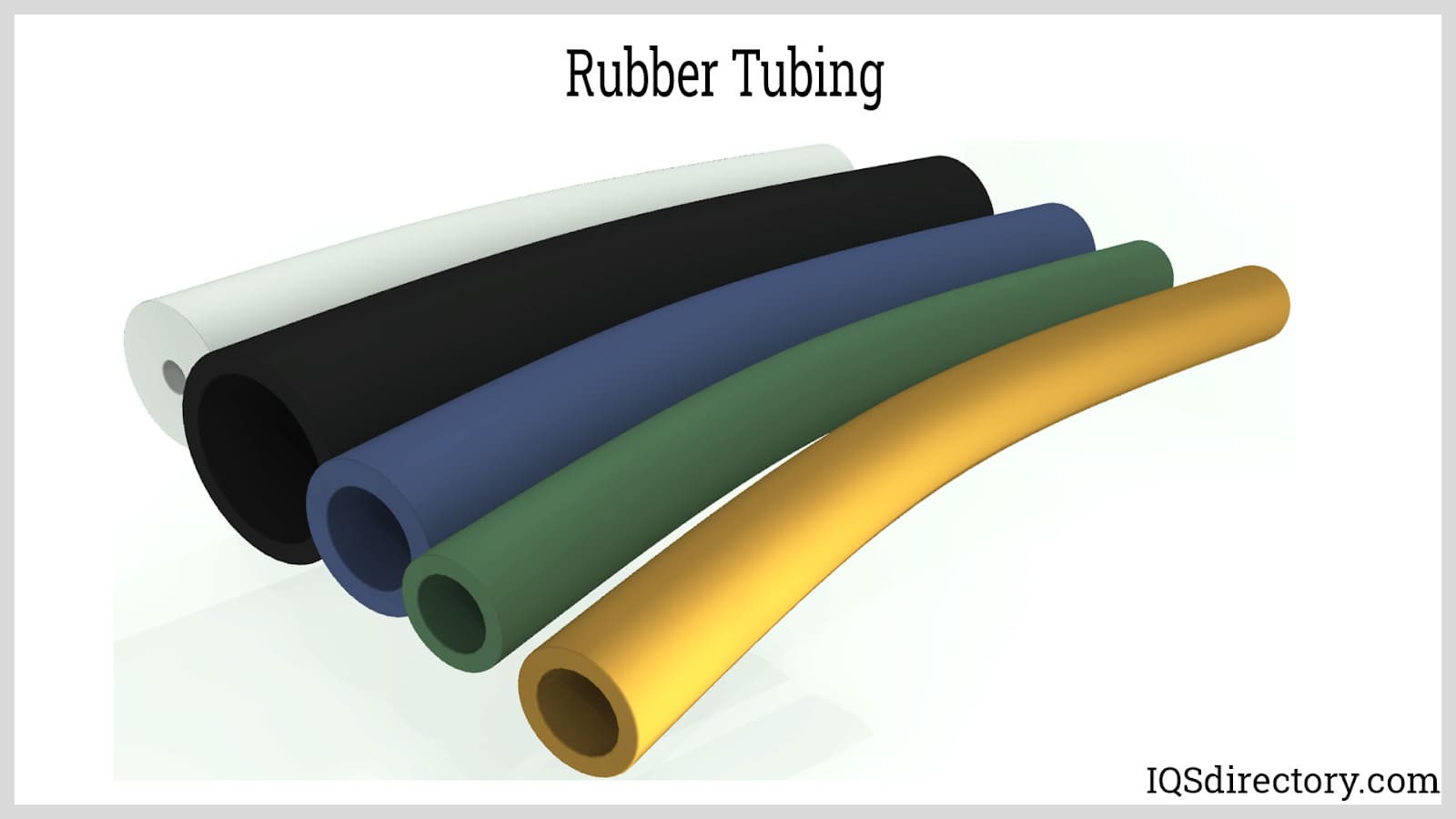
Rubber tubing, also known as rubber hose or piping, is made from a combination of natural and synthetic rubber. This versatile material is widely used for transporting and circulating liquids and...
Silicone tubing is a very tough elastomer that exhibits high strength, flexibility, and resistance. Silicone tubing can be stretched without tearing and is highly versatile. It cannot be weakened with repeated bending and twisting due to...
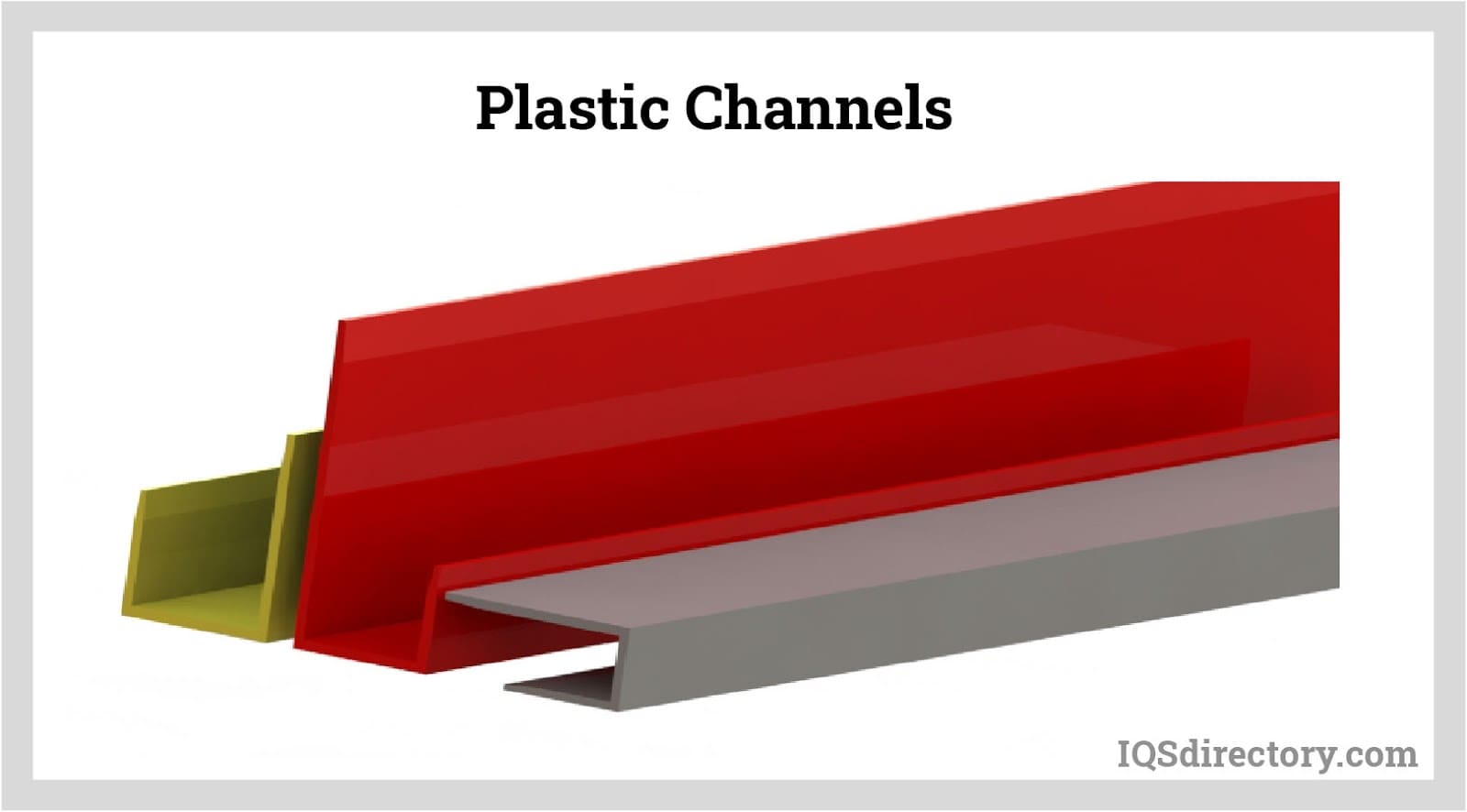
Plastic channels are plastic products that have linear extruded profiles. They have a constant cross-sectional shape across their axis. They are long and narrow structures, and their depth is relatively short. These products serve a variety of functions and uses...
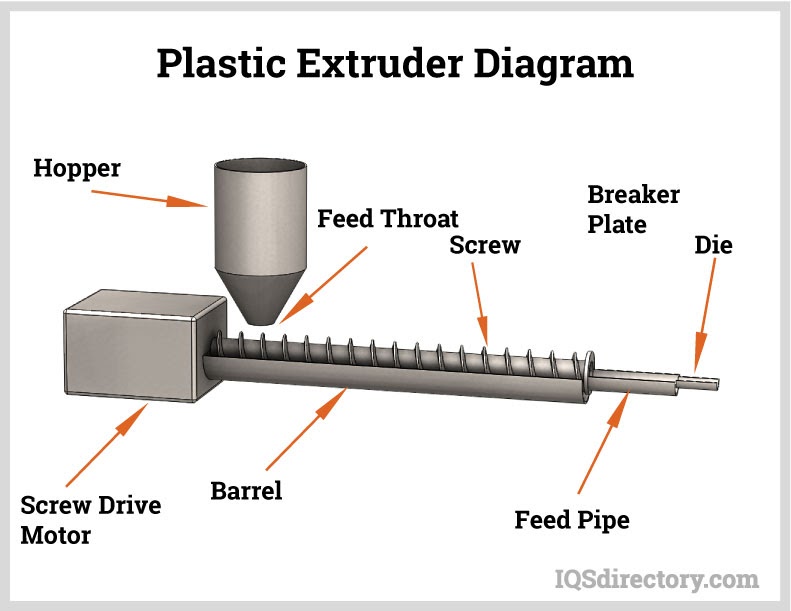
Plastic extrusion, also known as plasticating extrusion, is a continuous high volume manufacturing process in which a thermoplastic material -- in a form of powder, pellets or granulates -- is homogeneously melted and then forced out of the shaping die by means of pressure...
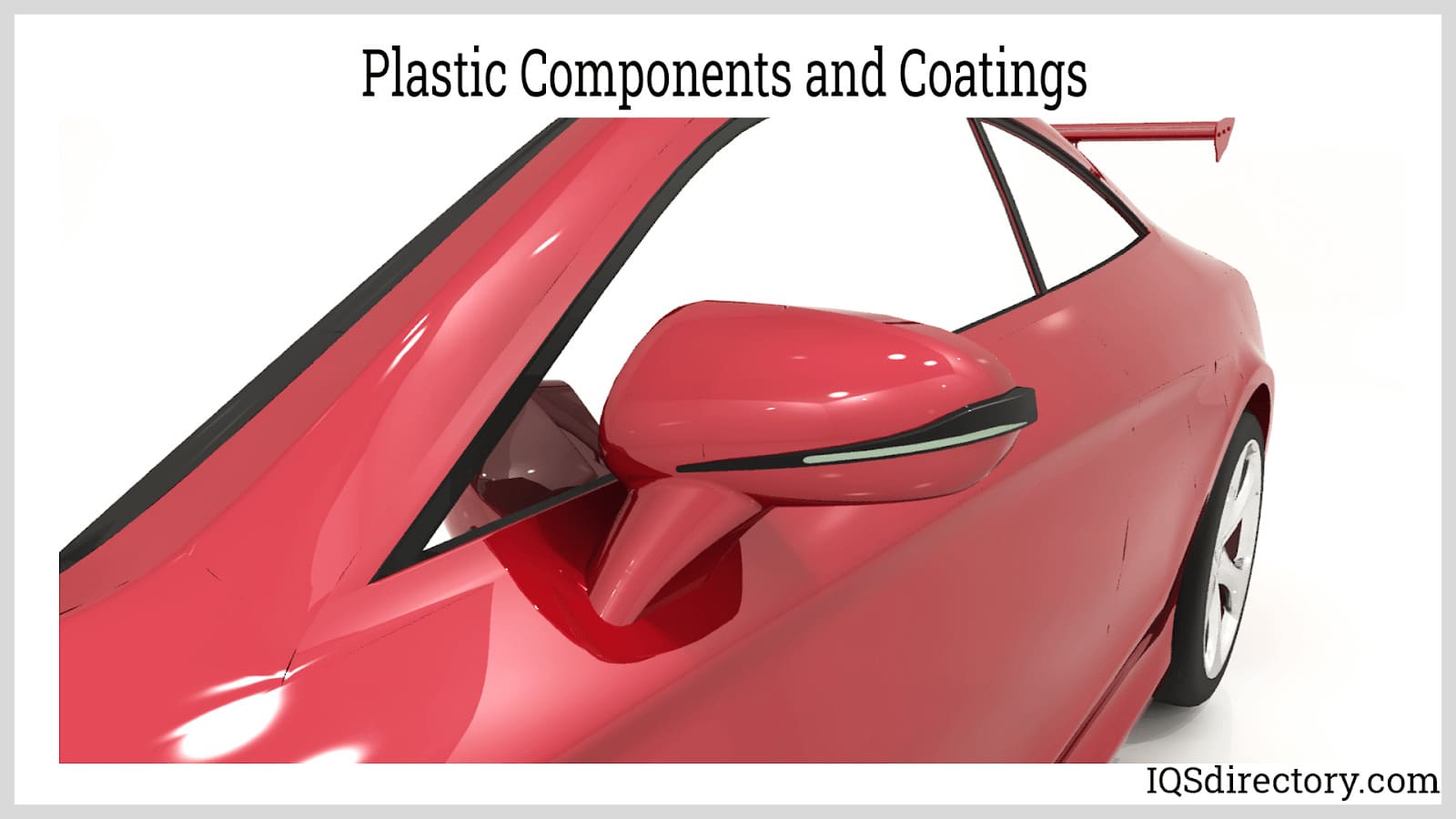
Plastic materials are objects artificially made from organic compounds called polymers along with other additive components. They possess excellent formability, making them extremely versatile for many different fabrication and manufacturing processes...
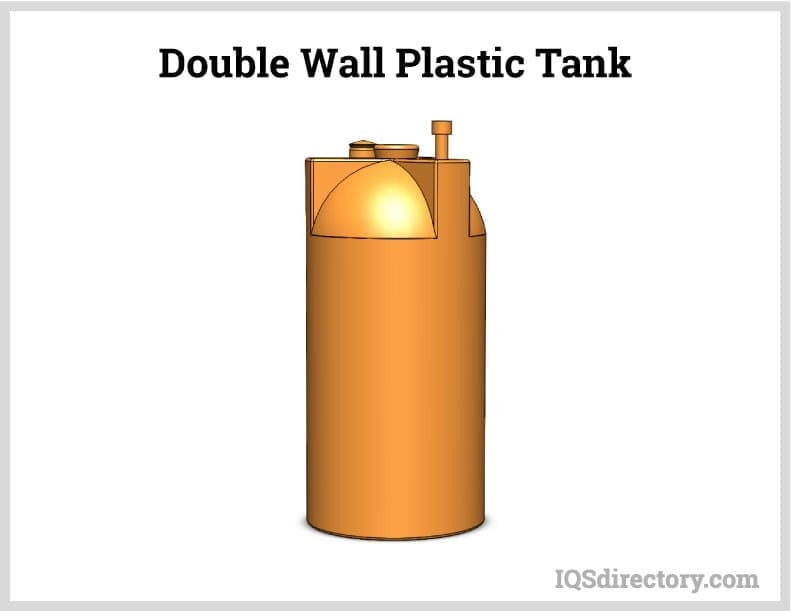
A plastic tank is a large capacity liquid or granular storage unit that can be vertical, horizontal, below or above ground, as well as movable. They are designed to hold several gallons of a variety of substances for long periods without experiencing wear, weathering, or deterioration...
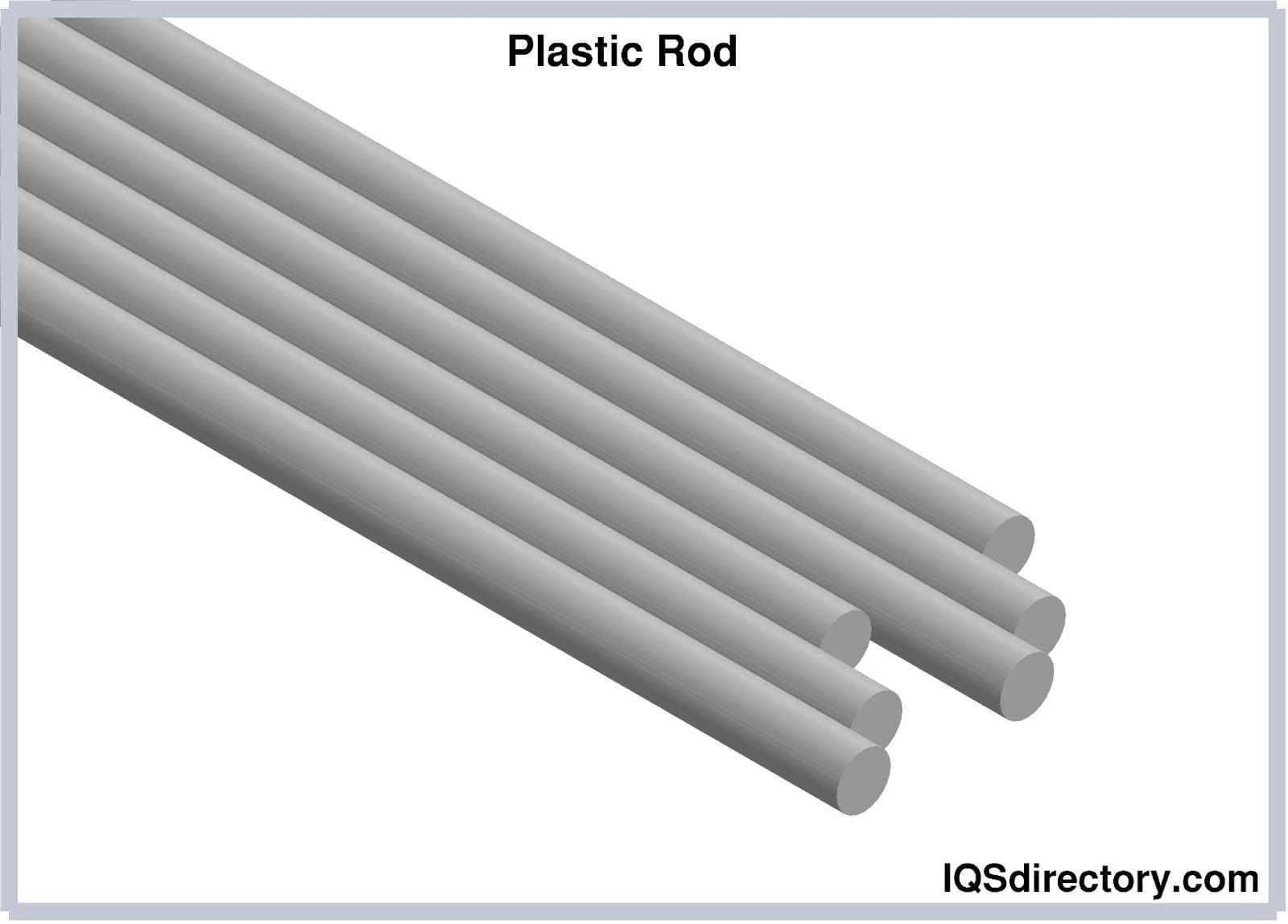
A plastic rod is a solid plastic shape made by the process of plastic extrusion or plastic co-extrusion. These have a contrast of plastic tubing and hollow plastic profiles. Plastic rods are found in various industries, including...
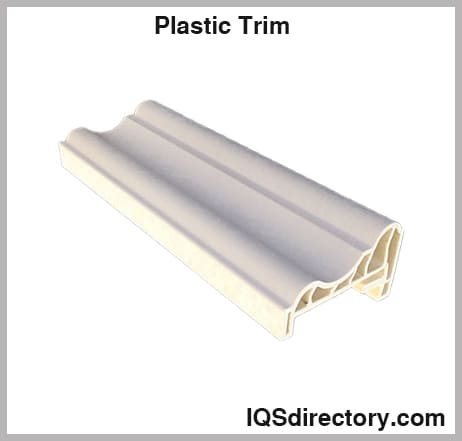
Plastic trim products are extruded linear profiles that can be made to any length. Because of its ability to attach, hold, and seal, plastic trim has many applications. Plastic, HDPE, LDPE, butyrate, PVC, acrylic, and...
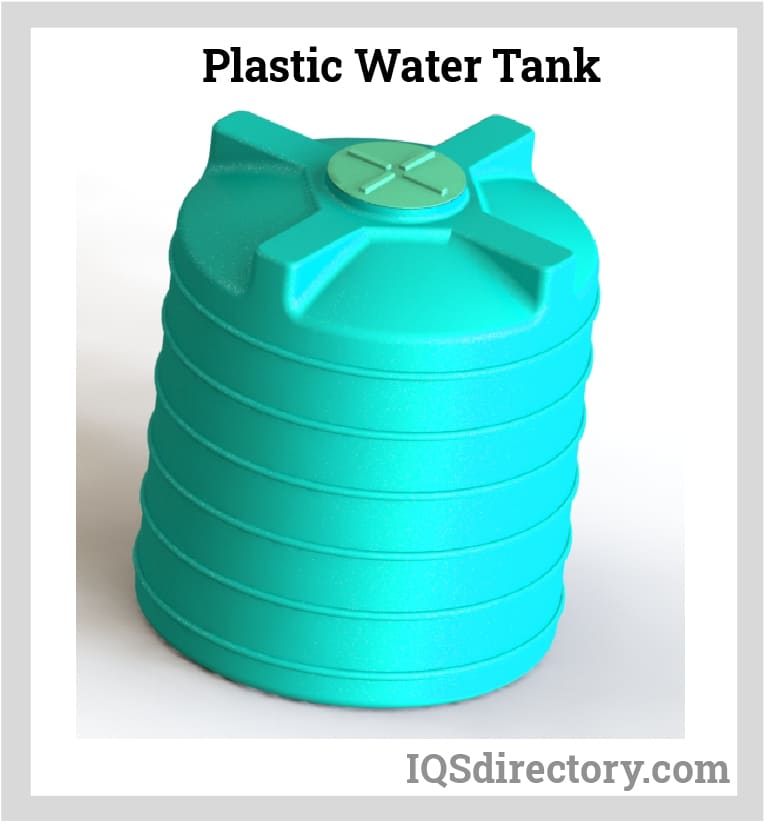
A plastic water tank is a large capacity container designed to store water for household, agricultural, irrigation, and industrial manufacturing use. There are various types of water tanks produced to meet the needs of specific applications, with...
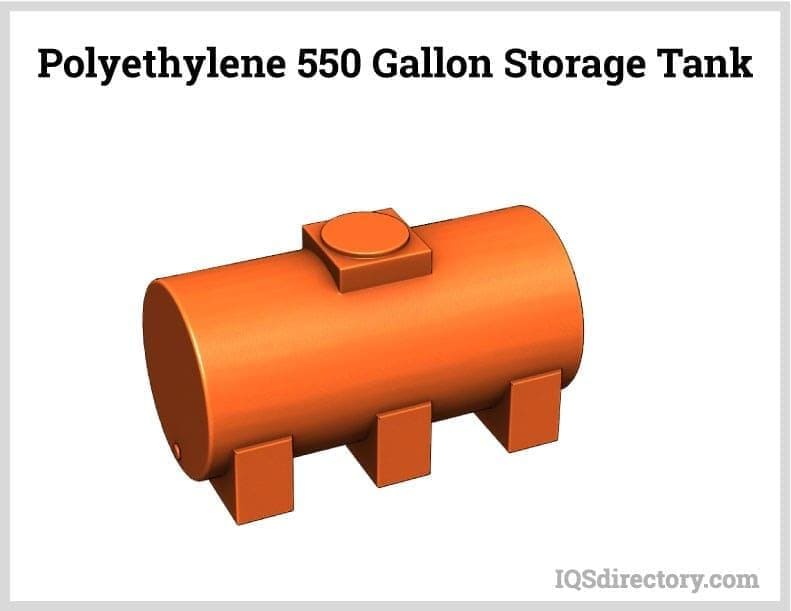
A poly tank is a plastic storage tank used to store, transport, and collect water, other liquids, and granular or powder materials. They are made of polyethylene or polypropylene and are a cost effective, lightweight, and easy to handle...
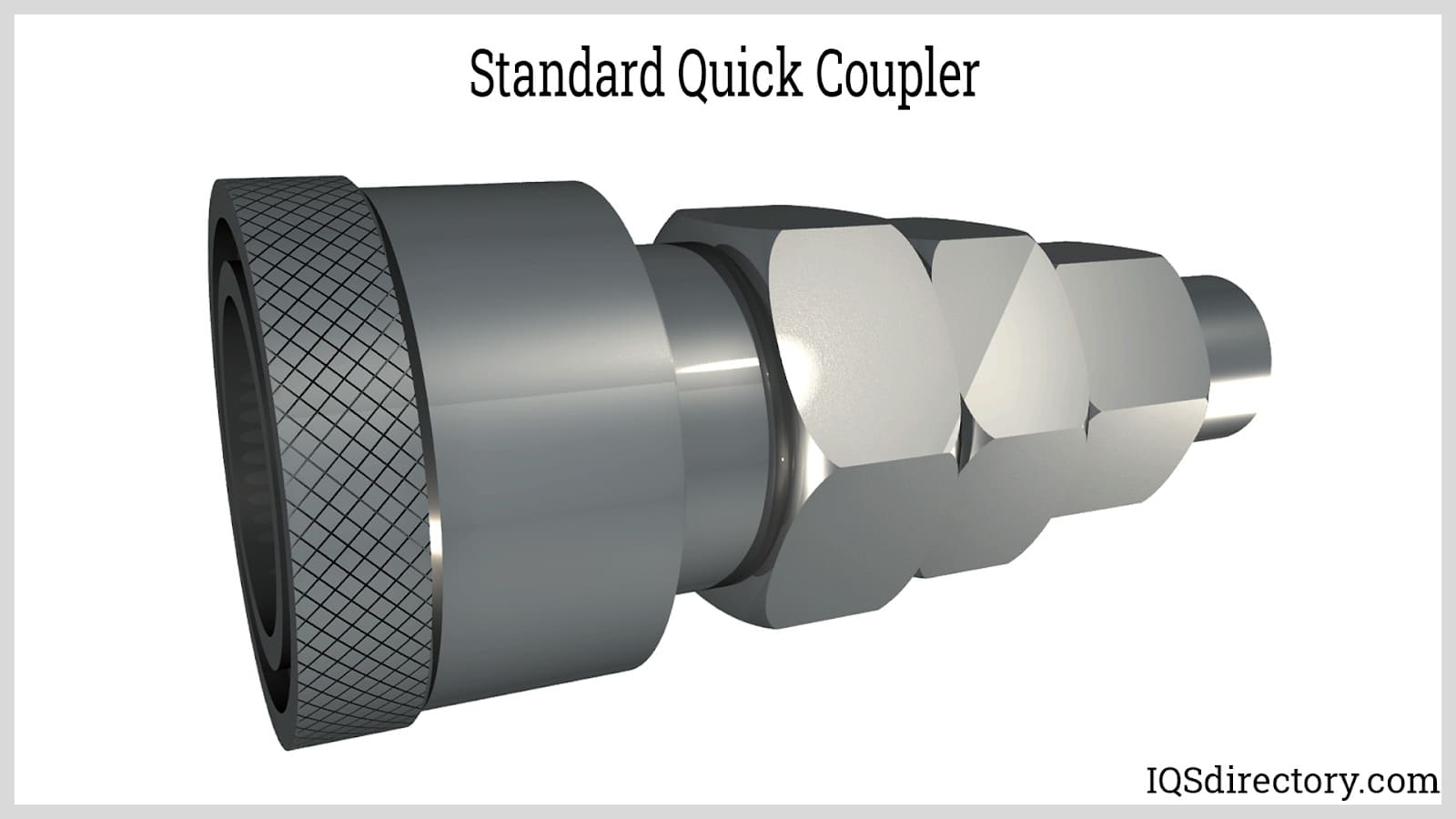
A coupling is a device that is used to transmit power between two shafts connected together at their ends. Couplings serve one primary purpose: to join two pieces of rotating equipment together, while...